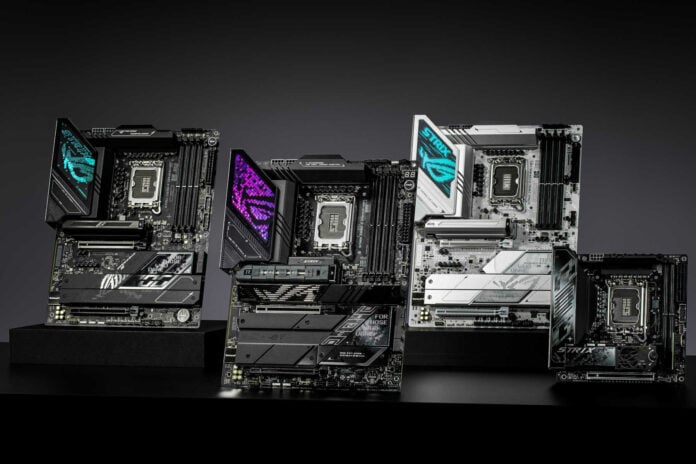Adopting a new platform can feel paralysing, particularly as motherboard manufacturers flood the market with seemingly similar models. Asus, for example, is launching 13 Z890 boards, all vying to be the one you take home to meet your new Core Ultra 200S processor. Each offers something unique, with varying features, prices, and specs. To demystify the differences, I’m here to explain and explore the lineup, helping you figure out if any are right for your system.
Before I dive into the hardware of each family, let’s discuss what software features you can expect from them. Whichever Asus motherboard you opt for, you’ll have access to ‘AI Advisor’. It’s a useful tool for both controlling and learning more about your system, offering advice on how optimise your components as well as providing explanations for your motherboard’s minutiae.
AI Cooling II also appears across the entire stack, serving as a fan curve optimiser to better balance noise and operating temperatures. Meanwhile, AI Networking II is available on all but one motherboard (Z890-P), optimising your network for peak performance.
Finally, all ROG and ProArt motherboards, as well as TUF Gaming Z890-Pro WiFi, support AI Overclocking. This tool aims to predict an optimal overclock by analysing your CPU’s temperatures in tandem with your cooler and adjusting frequencies accordingly.
With software covered, let’s talk hardware.
ROG Maximus
Sitting at the top of Asus’ Z890 motherboard stack is the ROG Maximus family. As the series’ name implies, these are the ones to reach for if you’re after every feature a ROG board can offer while also squeezing every drop of performance out of Core Ultra 200S processors. However, such qualities naturally command particularly premium prices.
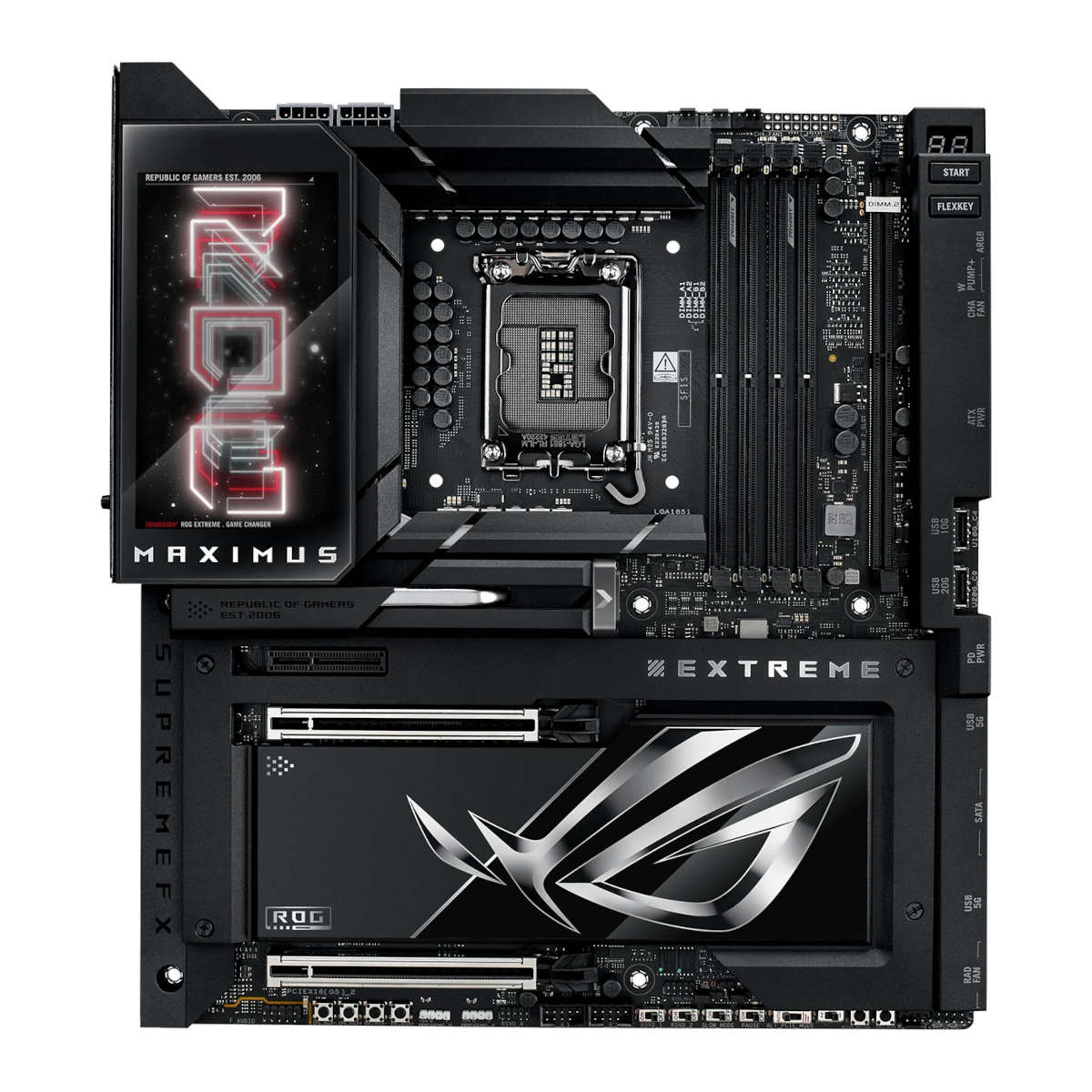
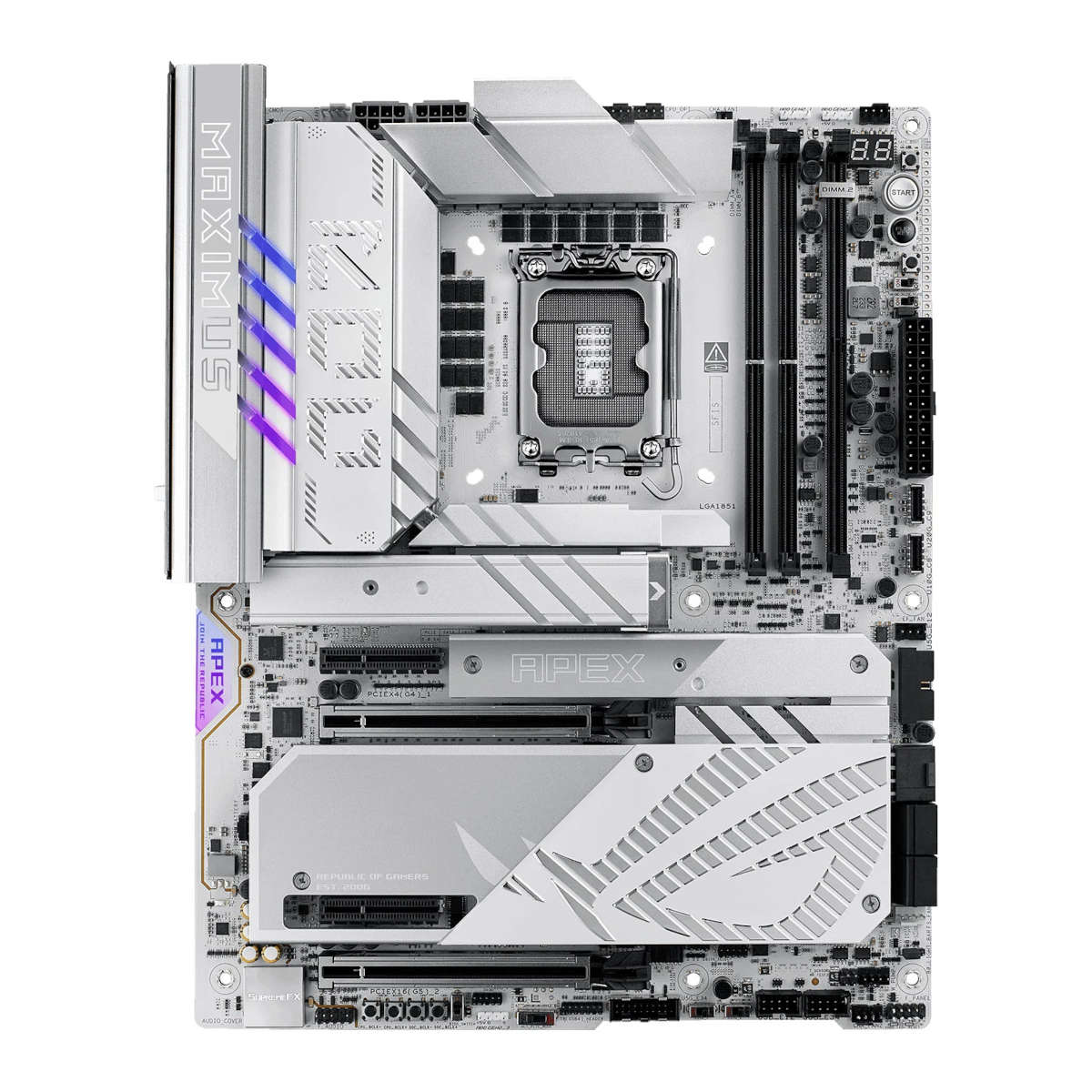
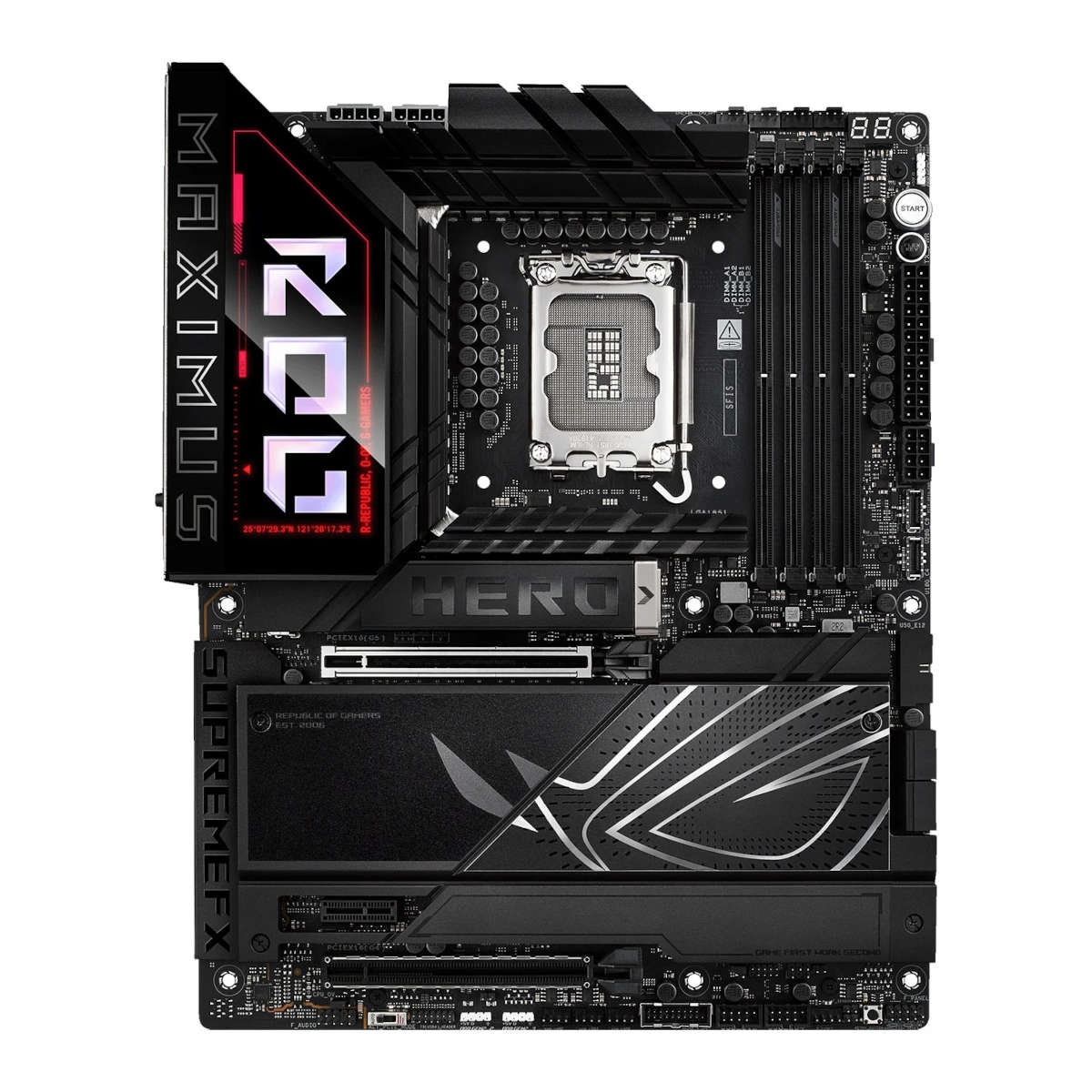
There are three ROG Maximus Z890 motherboards: Extreme, Apex, and Hero.
| Z890 Extreme | Z890 Apex | Z890 Hero | |
|---|---|---|---|
| Form factor | EATX | ATX | ATX |
| VRM | 24+1+2+2, 110A | 22+1+2+2, 110A | 22+1+2+2, 110A |
| RAM support | Slots: 4 Capacity: 192GB Speed: 9,200+MT/s | Slots: 2 Capacity: 96GB Speed: 9,600+MT/s | Slots: 4 Capacity: 192GB Speed: 9,200+MT/s |
| PCIe expansion | PCIe 5.0 x16 (x2) PCIe 4.0 x4 (x1) | PCIe 5.0 x16 (x2) PCIe 4.0 x4 (x2) | PCIe 5.0 x16 (x1) PCIe 4.0 x16 (x1) PCIe 4.0 x1 (x1) |
| Storage | PCIe 5.0 x4 (x3) PCIe 4.0 x4 (x1) | PCIe 5.0 x4 (x3) PCIe 4.0 x4 (x1) | PCIe 5.0 x4 (x3) PCIe 4.0 x4 (x3) |
| Networking | Marvell AQtion 10Gbps (x1) Intel 2.5Gbhps (x1) Wi-Fi 7 | Realtek 5Gbps (x1) Wi-Fi 7 | Realtek 5Gbps (x1) Intel 2.5Gbps (x1) Wi-Fi 7 |
| Audio | Realtek AC4082 ESS ES9219 Quad DAC | Realtek AC4080 Savitech SC3H712 amp | Realtek AC4082 ESS ES9219 Quad DAC |
| Rear USB | Thunderbolt 5 (x2) 20Gbps Type-C (x1) 10Gbps Type-C (x2) 10Gbps Type-A (x5) | Thunderbolt 4 (x2) 20Gbps Type-C (x1) 10Gbps Type-A (x4) 5Gbps Type-A (x4) | Thunderbolt 4 (x2) 10Gbps Type-C (x1) 10Gbps Type-A (x4) 5Gbps Type-A (x4) |
| Front USB | 20Gbps Type-C (x1) 10Gbps Type-C (x1) 5Gbps Type-A (x4) 480Mbps Type-A (x4) | 20Gbps Type-C (x1) 10Gbps Type-C (x1) 5Gbps Type-A (x4) 480Mbps Type-A (x4) | 20Gbps Type-C (x1) 10Gbps Type-C (x1) 5Gbps Type-A (x4) 480Mbps Type-A (x4) |
| Price | £1,360 | £767 | £720 |
Extreme
Leading the pack, ROG Maximus Z890 Extreme is one of the few Socket LGA1851 motherboards to boast dual Thunderbolt 5 connectivity. These ports offer an astounding 80Gbps of bandwidth, making them the fastest you’ll find on a consumer board.
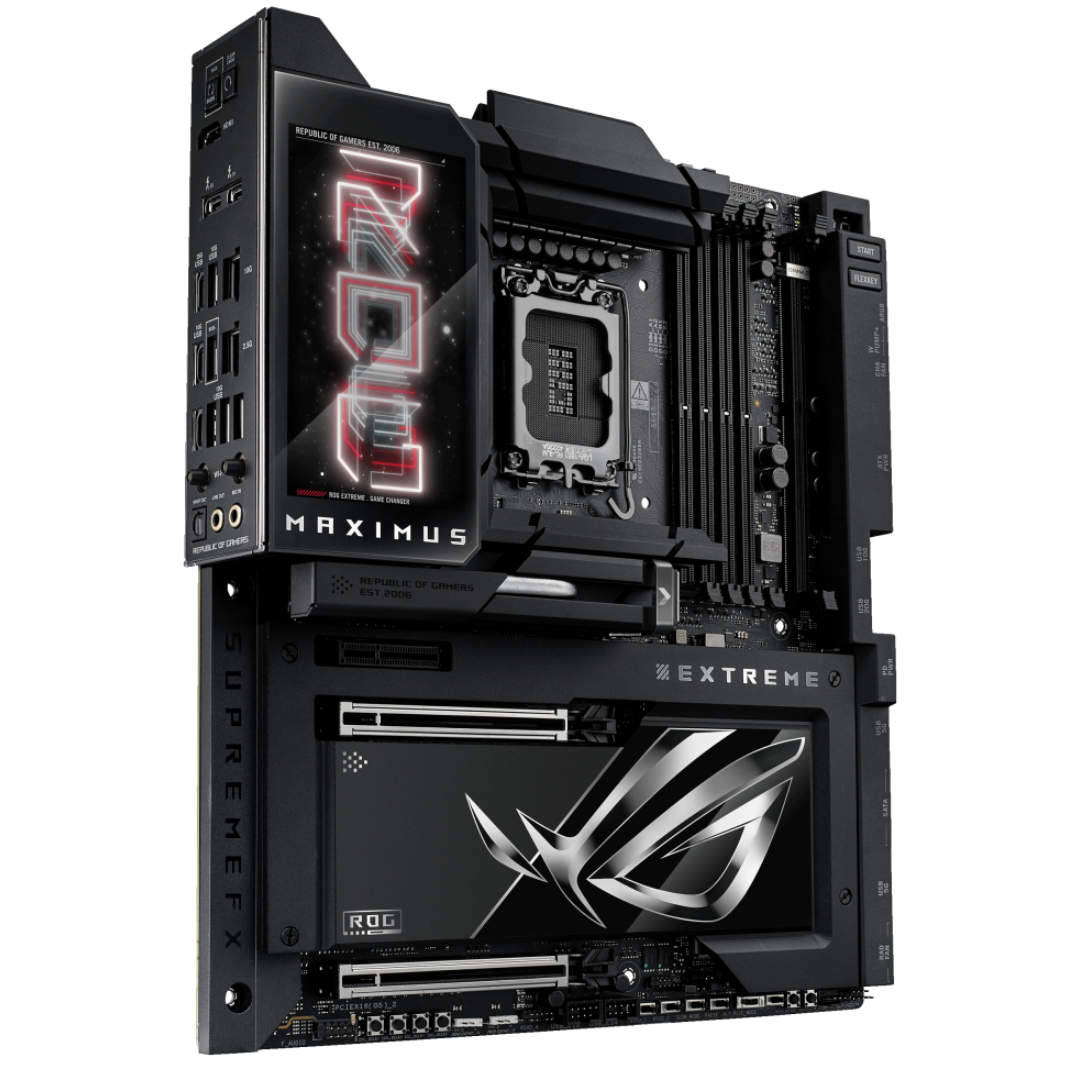
Asus ROG Maximus Z890 Extreme
Styled in refined black and charcoal hues, with intricate logo embossing and a layered mirrored finish atop the wide chipset heatsink, it’s a flagship motherboard in every sense of the word.
Cementing its status as a flagship gaming motherboard, ROG Maximus Z890 Extreme also features a practically bulletproof VRM with 24+1+2+2 power stages. This makes it an ideal choice to overclock the likes of Core Ultra 9 285K, with an LN2 mode also available for extreme overclocking.
Combined with features including NitroPath DRAM and ROG M.2 PowerBoost, each of which respectively boosts memory and storage performance, its gaming prowess is undeniable. It’s certainly not humble about it, either, with a 5in LCD screen built into its VRM heatsink that can either display hardware information or show off with flashy animations.
Apex
Overclockers with ambitions to shatter records should seek out ROG Maximus Z890 Apex. Swapping the four DIMM slots of its siblings out for two, it’s capable of supporting speeds up to 9,600+MT/s out of the box. This is among the fastest bases from which to build up to five-digit memory speeds if you’ve the know-how and guts to push RAM so far.
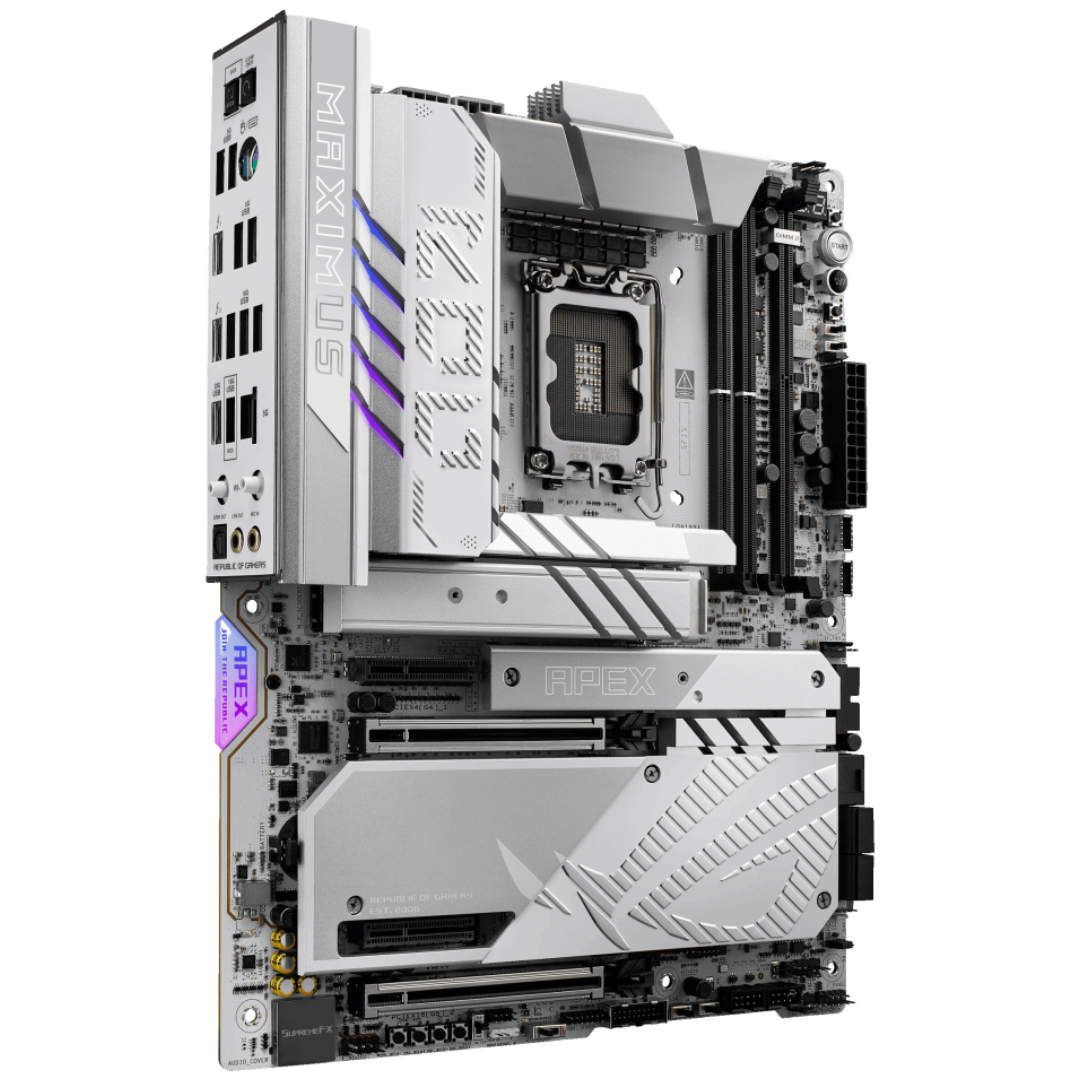
Asus ROG Maximus Z890 Apex
A favourite Z890 motherboard for overclocking enthusiasts, it’s also fantastic for those in the market to craft a dazzling white build that looks as cool as your CPU.
Keeping processors at sub-zero temperatures naturally comes at the risk of condensation. Apex aims to help make this less of a problem with specialised circuitry that detects when this bugbear rears its head, saving you from a potentially catastrophic short circuit. You’ll know ahead of time thanks to CPU, DRAM, or PCIe LEDs flashing before disaster strikes.
It’s also much more affordable than its bigger brother, at almost half the price. Apex trades much of the flash of Extreme to zone in on performance but retains many of the same useful features like Q-LED, Q-Code, Clear CMOS & BIOS Flashback, and a dedicated start button. Suffice it to say, it’s ready to overlock when you are.
Hero
For those longing for the closest alternative to Asus’ flagship board without wanting to break the bank, ROG Maximus Z890 Hero is here to save the day. Like Apex, it’s almost half the price of Extreme, but offers a more mainstream feature set than its overclocking-focussed sibling. That said, it does share the same 22+1+2+2 power stage VRM design.
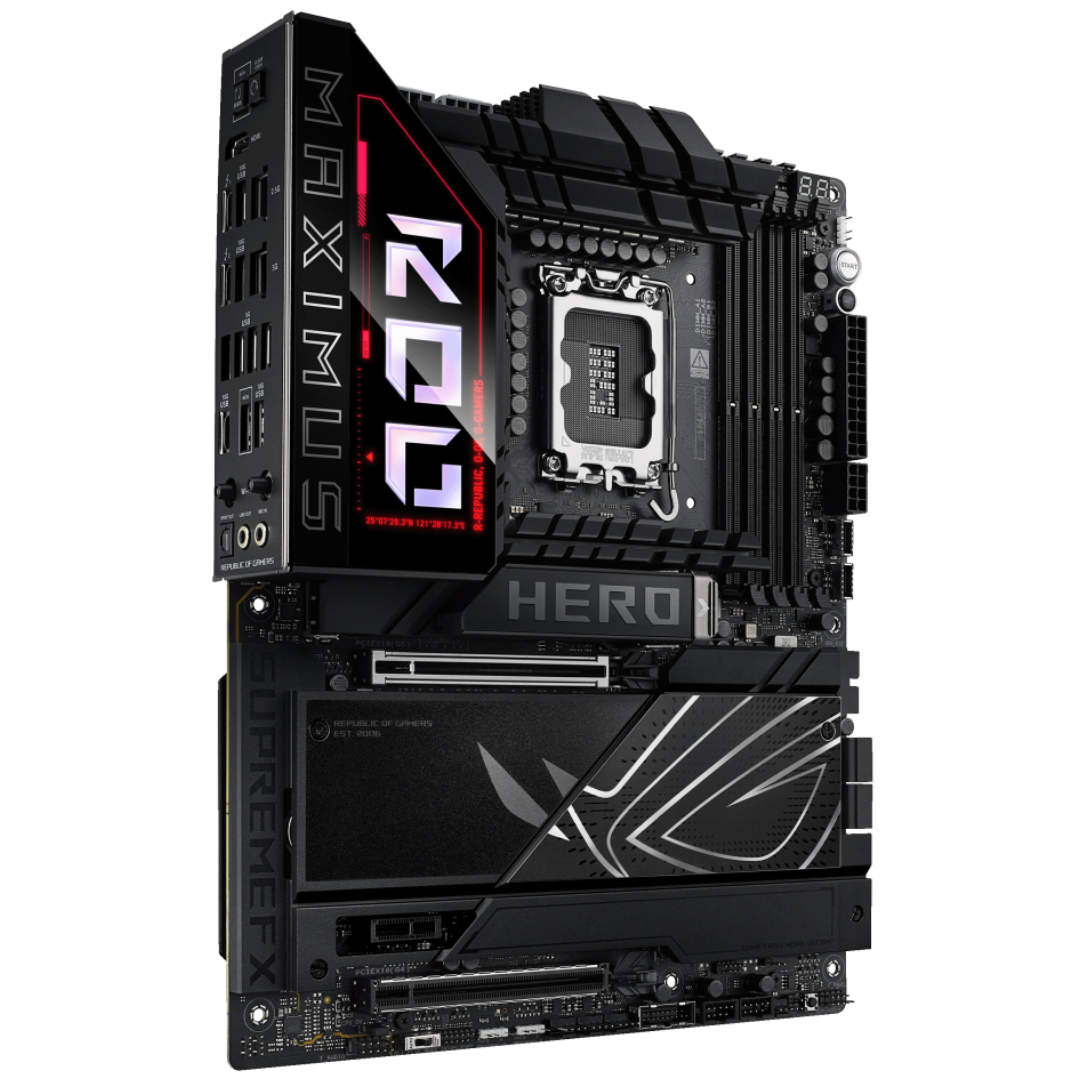
Asus ROG Maximus Z890 Hero
Loaded with premium features and built for unbridled performance, Hero takes the DNA of the bleeding-edge ROG Maximus Z890 Extreme and brings it to a wider audience.
In terms of differences, this board swaps out Thunderbolt 5 for Thunderbolt 4 but actually boasts more USB ports in total (13 vs. 12). On a similar note, it also natively supports more M.2 storage with six slots total. It retains dual Ethernet functionality, but its fastest port runs at 5Gbps rather than 10Gbps.
These relative differences, alongside the removal of Extreme’s LCD screen for some RGB, make Hero a sensible compromise for the price-conscious enthusiast. All important gaming features are duly present, like NitroPath DRAM and ROG M.2 PowerBoost, in addition to quality-of-life toolless releases for M.2 and PCIe cards.
ROG Strix
With four models to choose from, ROG Strix is the most varied family of Asus’ Z890 motherboards and the only range to feature an ITX option. These boards are for gamers seeking a more refined feature set and performance than what the company’s more affordable, mainstream options can offer. Expect more headroom to overclock, eye-catching Polymo Lighting effects, and plenty of fast USB ports.
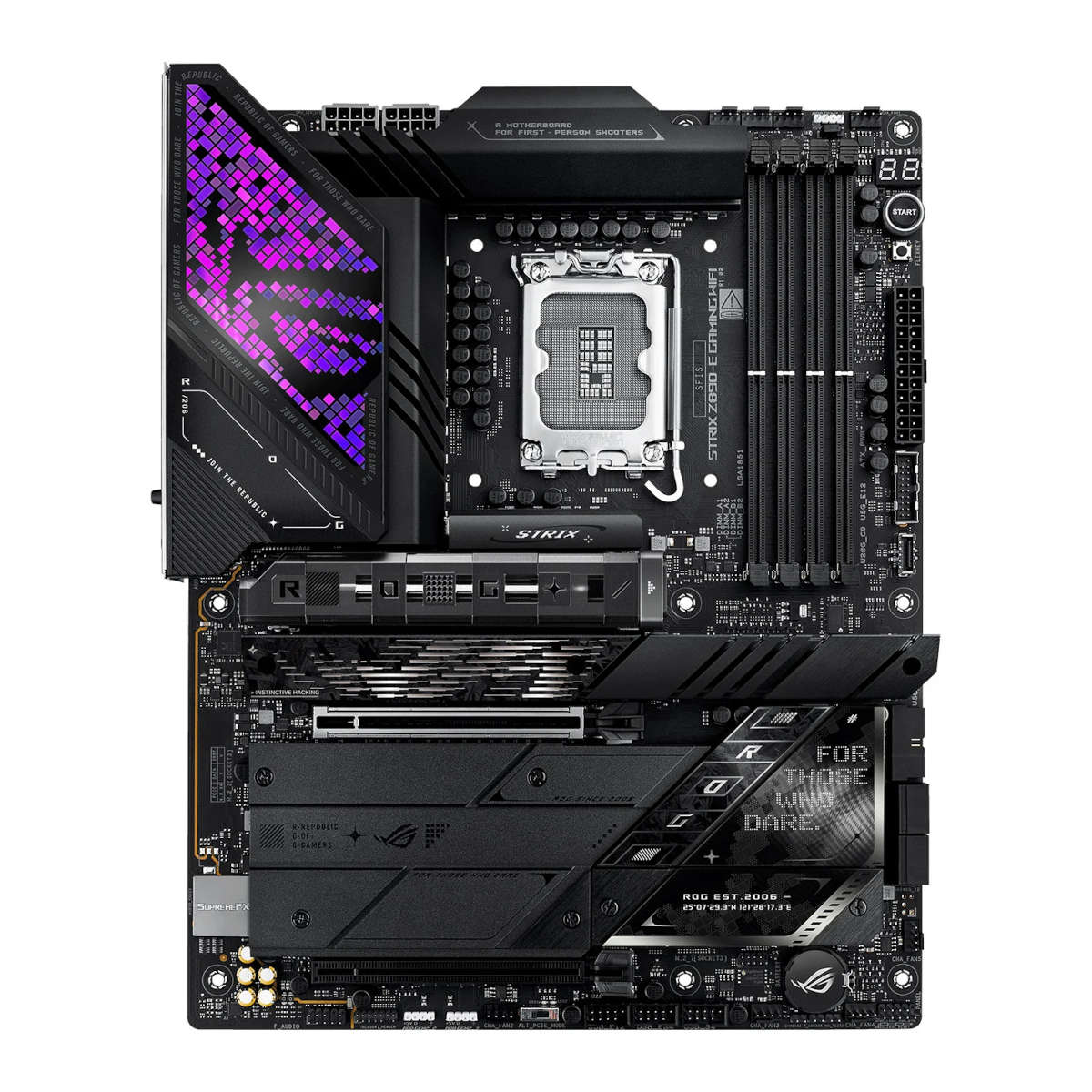
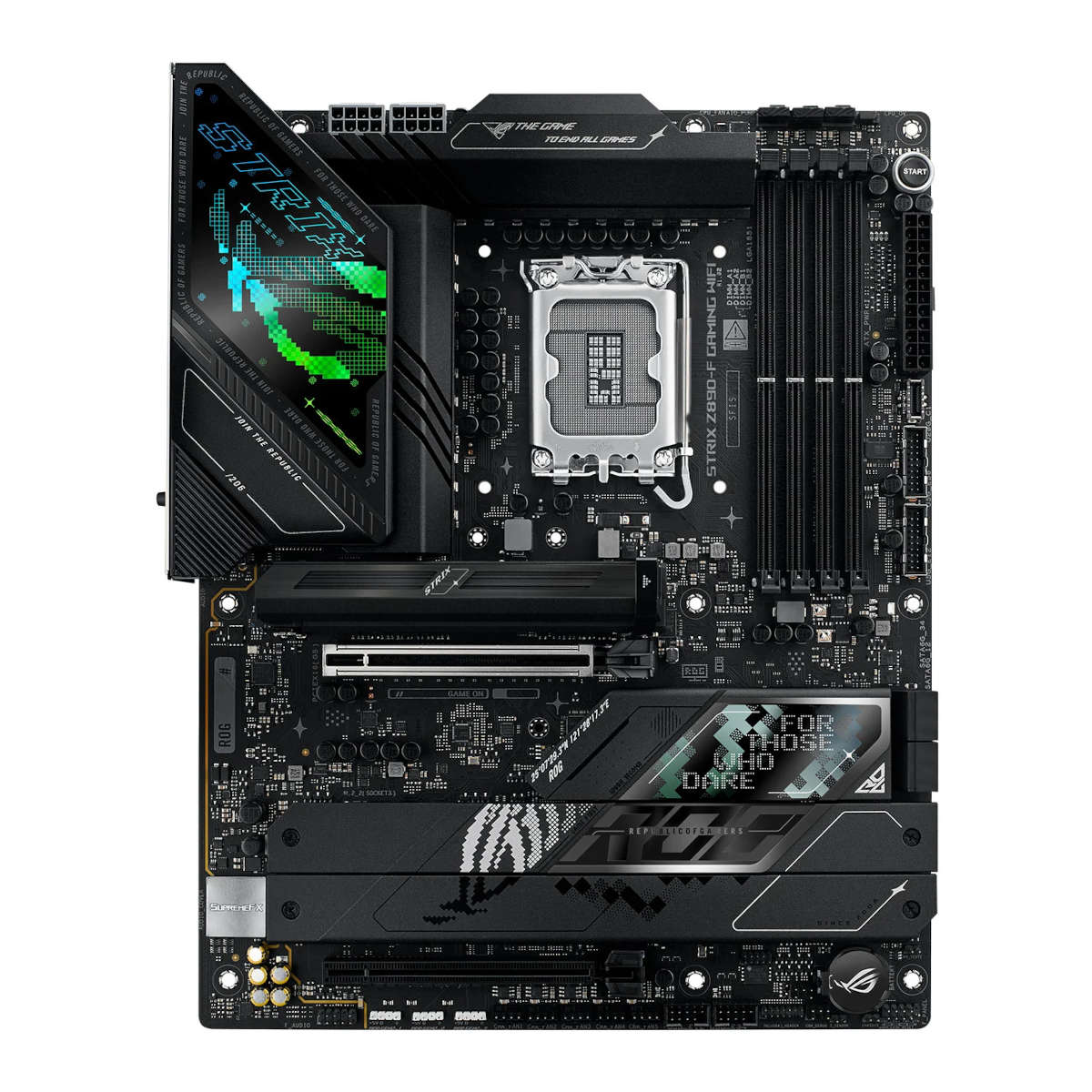
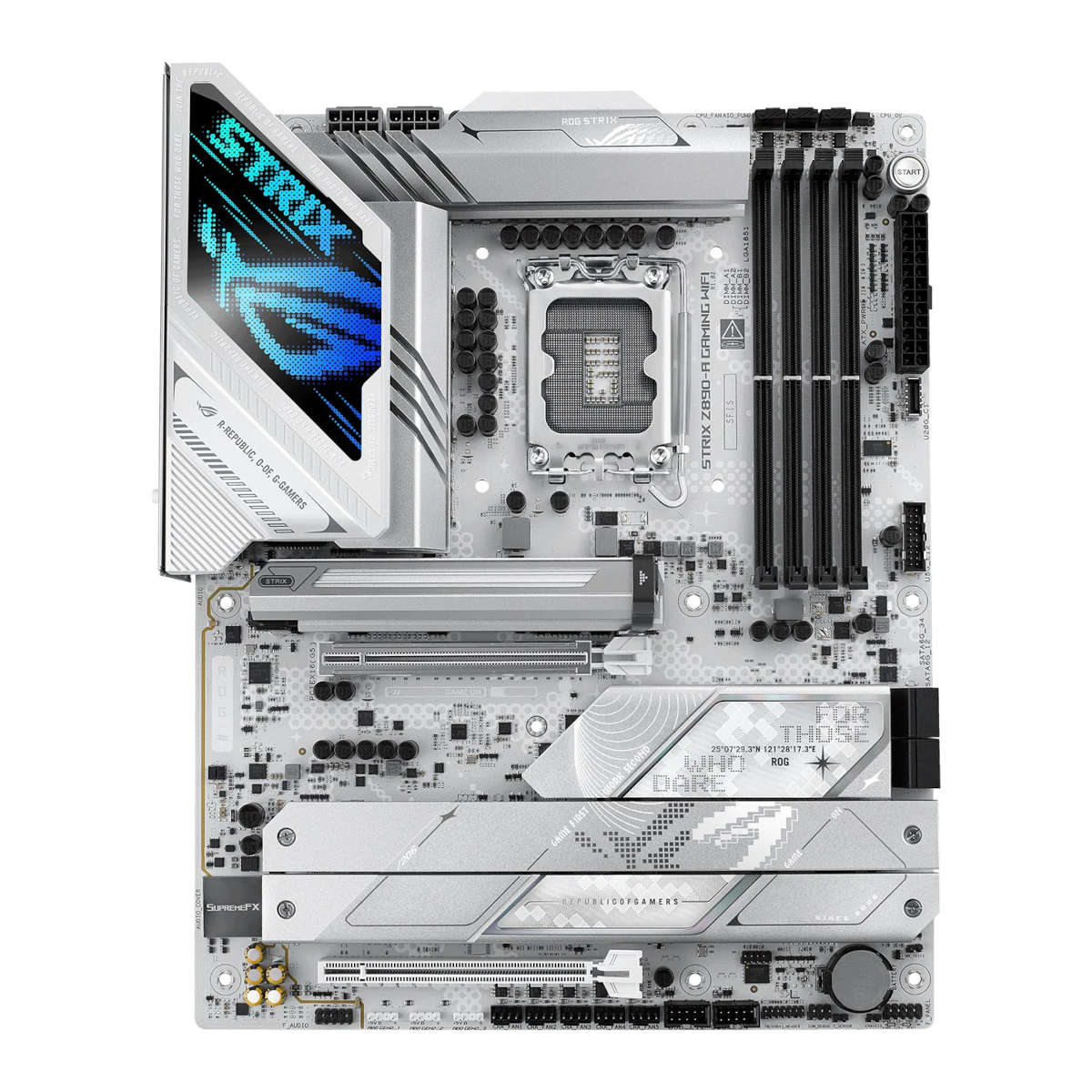
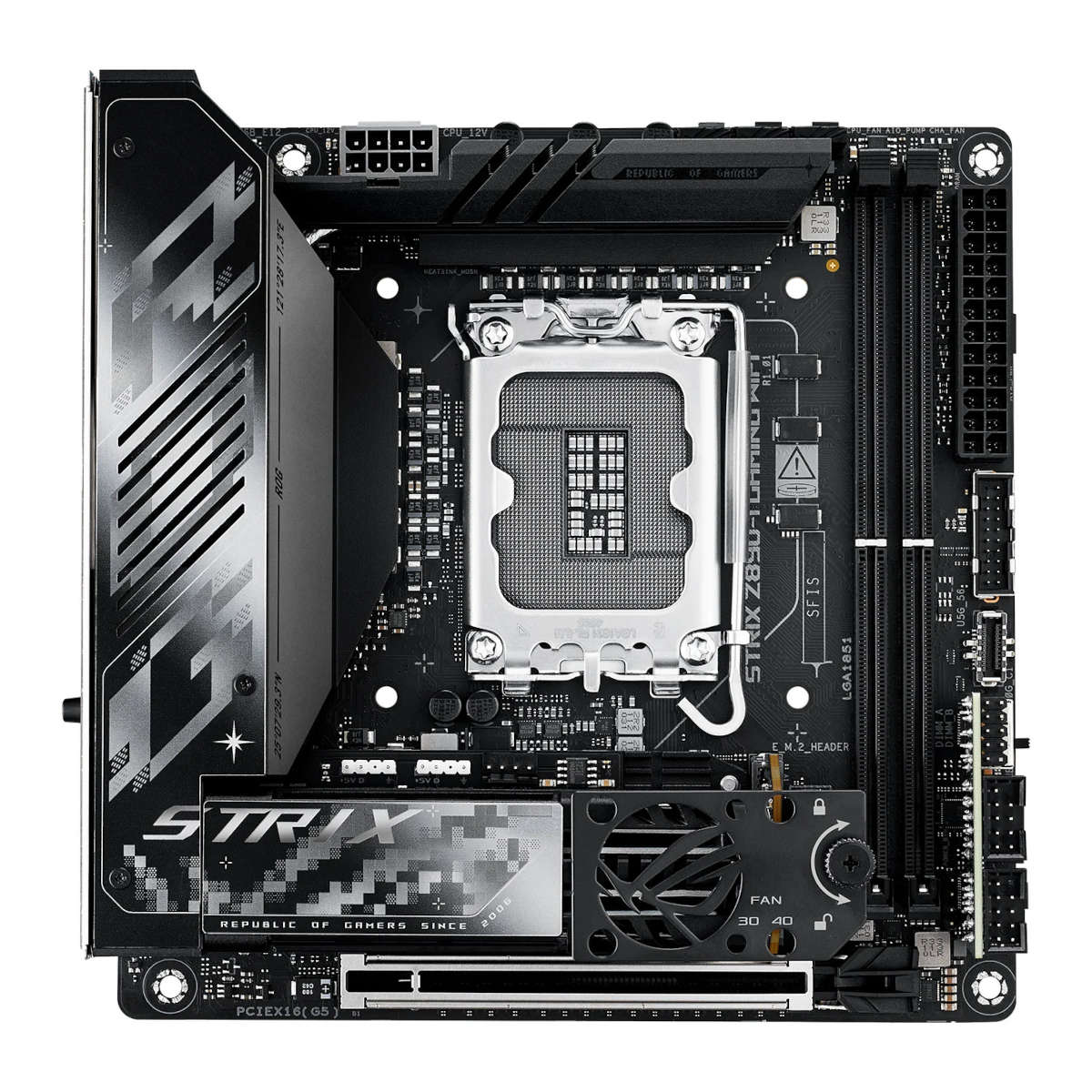
There are four ROG Strix Z890 motherboards: Z890-E Gaming WiFi, Z890-F Gaming WiFi, Z890-A Gaming WiFi, and Z890-I Gaming WiFi.
| Z890-E Gaming WiFi | Z890-F Gaming WiFi | Z890-A Gaming WiFi | Z890-I Gaming WiFi | |
|---|---|---|---|---|
| Form factor | ATX | ATX | ATX | Mini-ITX |
| VRM | 18+1+2+2, 110A | 16+1+2+2, 110A | 16+1+2+2, 90A | 10+1+2+1, 110A |
| RAM support | Slots: 4 Capacity: 192GB Speed: 8,800+MT/s | Slots: 4 Capacity: 192GB Speed: 8,600+MT/s | Slots: 4 Capacity: 192GB Speed: 8,600+MT/s | Slots: 2 Capacity: 96GB Speed: 9,200+MT/s |
| PCIe expansion | PCIe 5.0 x16 (x1) PCIe 4.0 x16 (x1) | PCIe 5.0 x16 (x1) PCIe 4.0 x16 (x1) | PCIe 5.0 x16 (x1) PCIe 4.0 x16 (x1) | PCIe 5.0 x16 (x1) |
| Storage | PCIe 5.0 x4 (x3) PCIe 4.0 x4 (x4) SATA 6Gbps (x4) | PCIe 5.0 x4 (x1) PCIe 4.0 x4 (x4) SATA 6Gbps (x4) | PCIe 5.0 x4 (x1) PCIe 4.0 x4 (x4) SATA 6Gbps (x4) | PCIe 5.0 x4 (x2) |
| Networking | Realtek 5Gbps (x1) Wi-Fi 7 | Intel 2.5Gbps (x1) Wi-Fi 7 | Intel 2.5Gbps (x1) Wi-Fi 7 | Intel 2.5Gbps Wi-Fi 7 |
| Audio | Realtek ALC4080 Savitech SV3H712 amp | Realtek ALC4080 Savitech SV3H712 amp | Realtek ALC4080 Savitech SV3H712 amp | Realtek ALC 4050 ESS Sabre 9260Q DAC |
| Rear USB | Thunderbolt 4 (x2) 10Gbps Type-C (x2) 10Gbps Type-A (x7) 5Gbps Type-A (x3) | Thunderbolt 4 (x2) 10Gbps Type-C (x2) 10Gbps Type-A (x4) 5Gbps Type-A (x4) 480Mbps Type-A (x2) | Thunderbolt 4 (x2) 10Gbps Type-C (x1) 10Gbps Type-A (x5) 5Gbps Type-A (x2) | Thunderbolt 4 (x2) 20Gbps Type-A (x1) 10Gbps Type-A (x3) 5Gbps Type-A (x1) 480Mbps Type-A (x2) |
| Front USB | 20Gbps Type-C (x1) 5Gbps Type-A (x4) 480Mbps Type-A (x6) | 20Gbps Type-C (x1) 5Gbps Type-A (x4) 480Mbps Type-A (x4) | 20Gbps Type-C (x1) 5Gbps Type-A (x2) 480Mbps Type-A (x4) | 20Gbps Type-C (x1) 5Gbps Type-A (x2) |
| Price | £555 | £479 | £454 | £479 |
E Gaming WiFi
The most feature-rich ROG Strix Z890 motherboard is E Gaming WiFi, curiously ahead of the F Gaming WiFi. Branding idiosyncrasies are easy to put aside while absorbing the board’s specs, though. For starters, it boasts an overwhelming amount of USB ports, with nine of its 14 connectors running at 10Gbps. Of course, its two Thunderbolt 4 ports take the lead in terms of speed at 40Gbps.
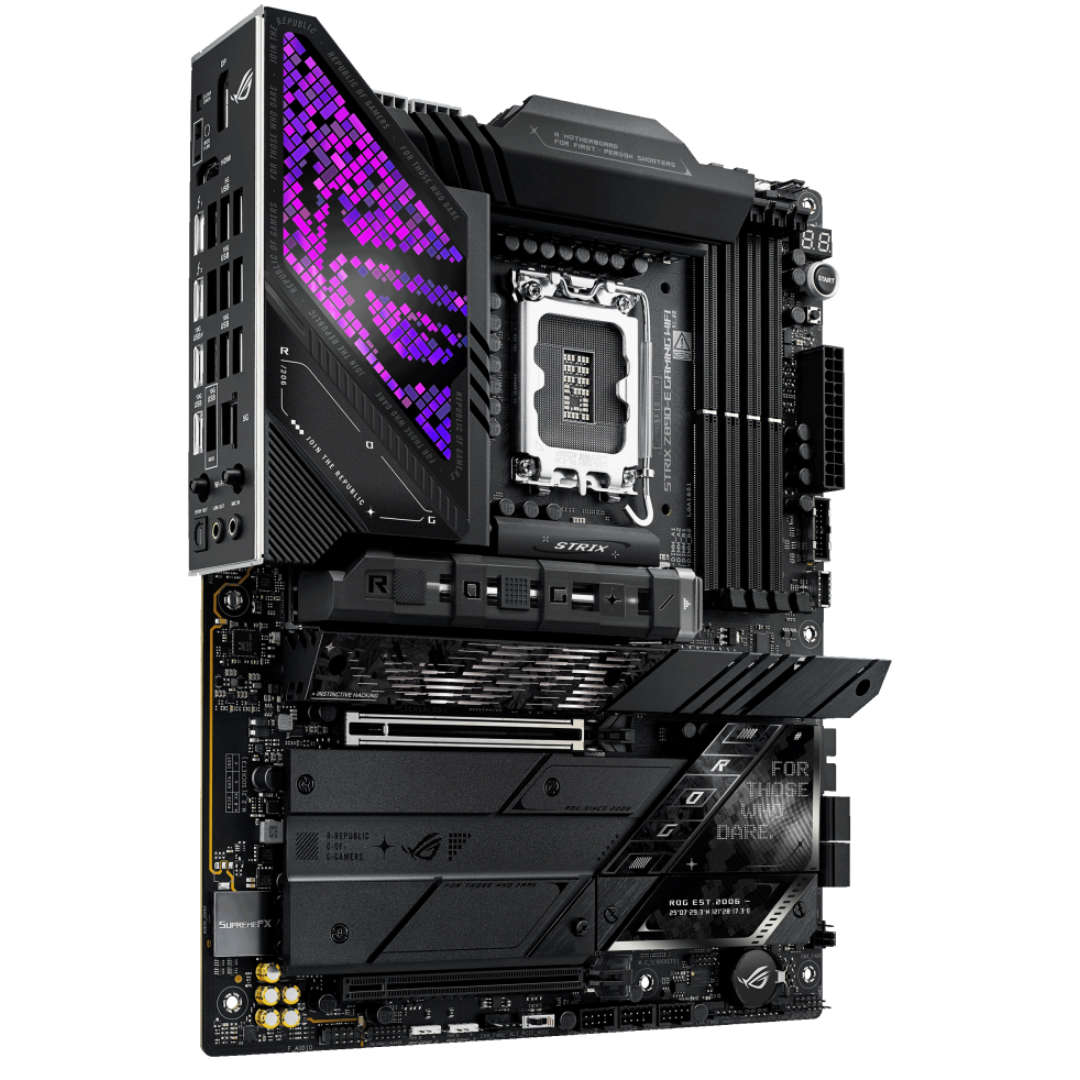
Asus ROG Strix Z890-E WiFi
Alongside robust power architecture and more M.2 slots than you can shake a stick at, this is one of the first Strix motherboards to get the eye-catching Polymo Lighting design on its I/O shroud.
This board’s no slouch when it comes to storage either, matching its Maximus counterparts with three PCIe 5.0 x4 M.2 slots. Better still, it exceeds the more expensive boards with an additional four PCIe 4.0 x4 slots and four SATA 6Gbps headers. I’m slightly awestruck just thinking of all the data this £555 motherboard can handle.
Punching above its weight, it’s also the only ROG Strix board to tout both NitroPath DRAM and ROG M.2 PowerBoost performance enhancements. It does cut back on power phases (18+1+2+2) and RAM speeds (8,8800+MT/s) relative to Maximus motherboards, but these specs are still plenty strong to handle overclocking Core Ultra 200S.
F Gaming WiFi
Speaking from personal experience, having written the ROG Strix Z890-F Gaming WiFi review for Club386, it’s a rock-solid motherboard. Asus makes smart cutbacks from E Gaming WiFi, such as reducing the number of PCIe 5.0 M.2 expansion slots from three to one, but leaves core functionality intact at a more affordable price point.
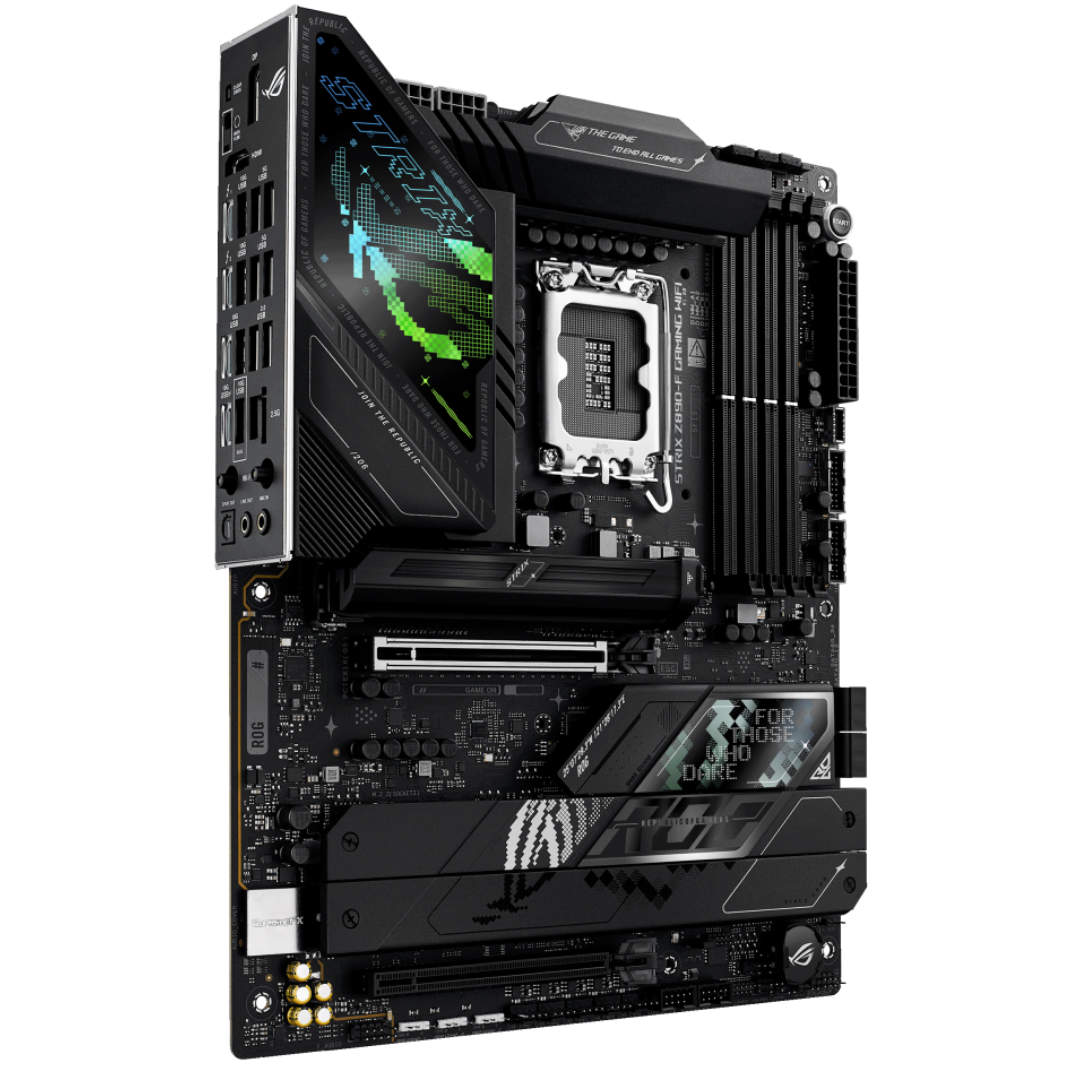
Asus ROG Strix Z890-F WiFi
Taking a more mainstream approach with a focussed feature set, it still contains everything you need from the latest motherboards, including Thunderbolt 4, WiFi 7, and quick DDR5 memory.
F Gaming WiFi forgoes NitroPath DRAM but still supports overclocked memory speeds of up to 8,600+MT/s, just 200MT/s shy of its bigger brother. In terms of gaming performance, we’re talking about leaving behind a handful of frames at most, should the game even be memory-sensitive at all. If you’re the kind of person to set and forget an XMP profile without any further tinkering, I wouldn’t even give such differences a second thought.
This same logic applies to the board’s USB connectivity and wired networking speeds. You still have the same number of ports at your disposal, just at a slightly lower bandwidth. If you can’t go above £500 for a motherboard, F Gaming WiFi delivers a great experience for your money that will leave you happy you didn’t overstretch your budget.
A Gaming WiFi
With its white colour palette, A Gaming WiFi starkly contrasts against its brethren and shares much in common with F Gaming WiFi. This should come as no surprise given the mere £25 price gap between the two boards (£479 vs. £454). Although, this isn’t entirely down to its colour scheme.
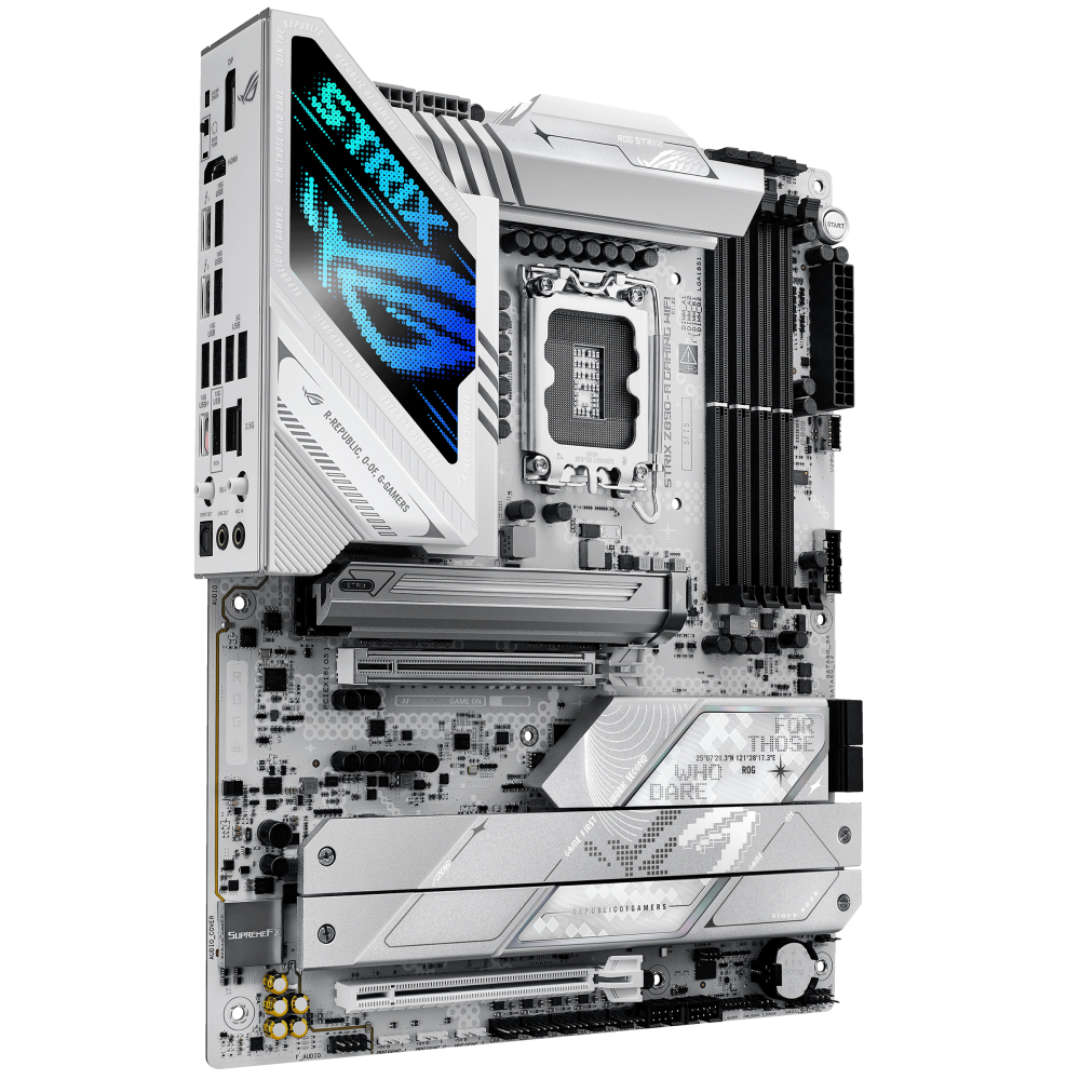
Asus ROG Strix Z890-A WiFi
Mirroring much of its Z890-F sibling with plentiful and speedy M.2 slots, this deserves the A grade with its snowy white approach that’ll suit any bleached build.
Aside from aesthetics, the only major difference between A Gaming WiFi relative to F Gaming WiFi is in USB connectivity. The former features fewer ports, ten in total, but offers more 10Gbps Type-A connectors than its closest relative.
If you can manage with fewer USB headers at your disposal, A Gaming WiFi is otherwise a dead-ringer for F Gaming WiFi in terms of specifications. As such, it’d make a great choice for a premium mid-range all-white system. In fact, I’d argue it’s the better-looking board.
I Gaming WiFi
Small Form Factor (SFF) PCs are growing in number by the day, with more examples of excellent chassis joining the market. As such, it’s only right that motherboard manufacturers play their part in keeping the space healthy with Mini-ITX models. On that note, I Gaming WiFi is plenty qualified.
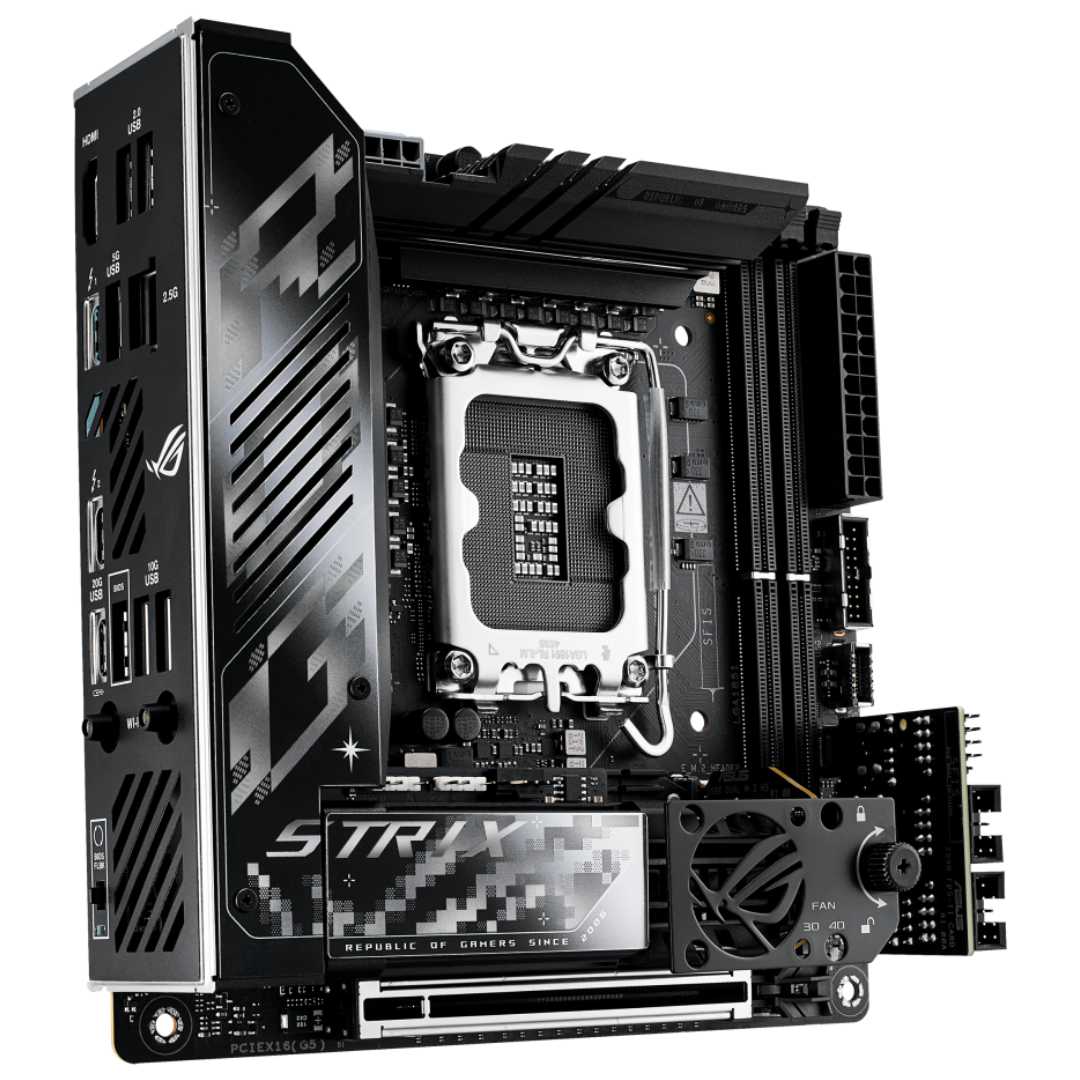
Asus ROG Strix Z890 I-Gaming WiFi
The dinkiest way to upgrade to Core Ultra 200S, this mini-ITX motherboard wisely uses its limited space, even thinking outside the box by putting its audio solution in an external ESS Sabre 9260Q DAC. Clever.
While its core specifications are solid in their own right, ROG Strix Hive II gives the motherboard a unique edge. In addition to providing an additional two 10Gbps ports (one Type-A, one Type-C), it provides a convenient way to troubleshoot and interact with your SFF PC. It packs a Q-OLED for the former and dedicated power reset buttons for the latter, as well as a volume control dial and headphone jack input.
It’s the only Mini-ITX option in Asus’ entire Z890 lineup, ROG Strix or otherwise. Thankfully, it crams so much functionality into its small package that it’s difficult to long for more choices. Performance looks solid, too, with support for up to 9,200+MT/s memory speeds. Just a few hundred megatransfers off Apex.
TUF Gaming
The peoples’ champions, TUF Gaming motherboards. These sub-£400 models balance performance and affordability, delivering high-value options to mainstream gamers. While this family trades away some of the more fanciful features of ROG Strix and Maximus, they’re by no means plain with an industrial aesthetic that pops inside a case.
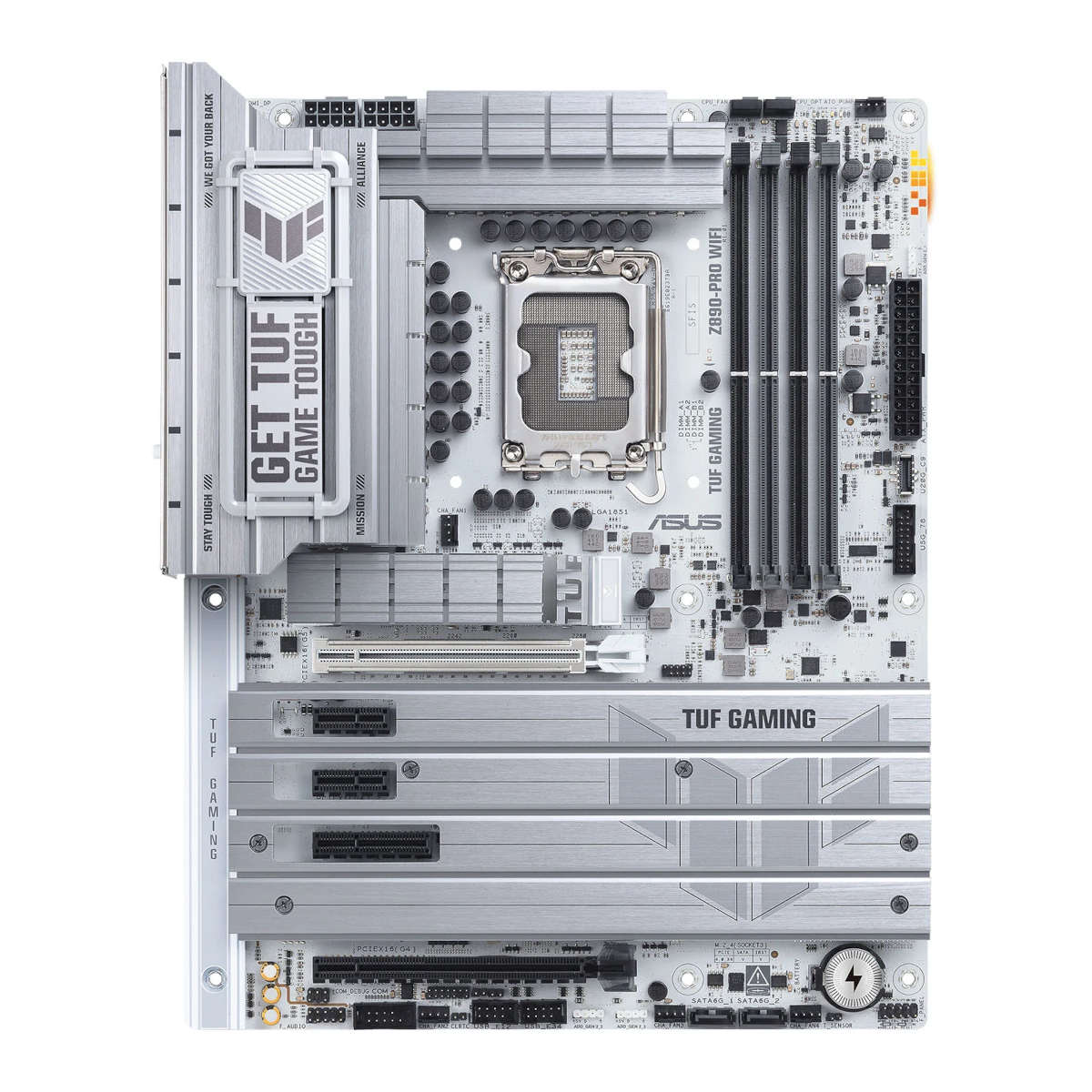
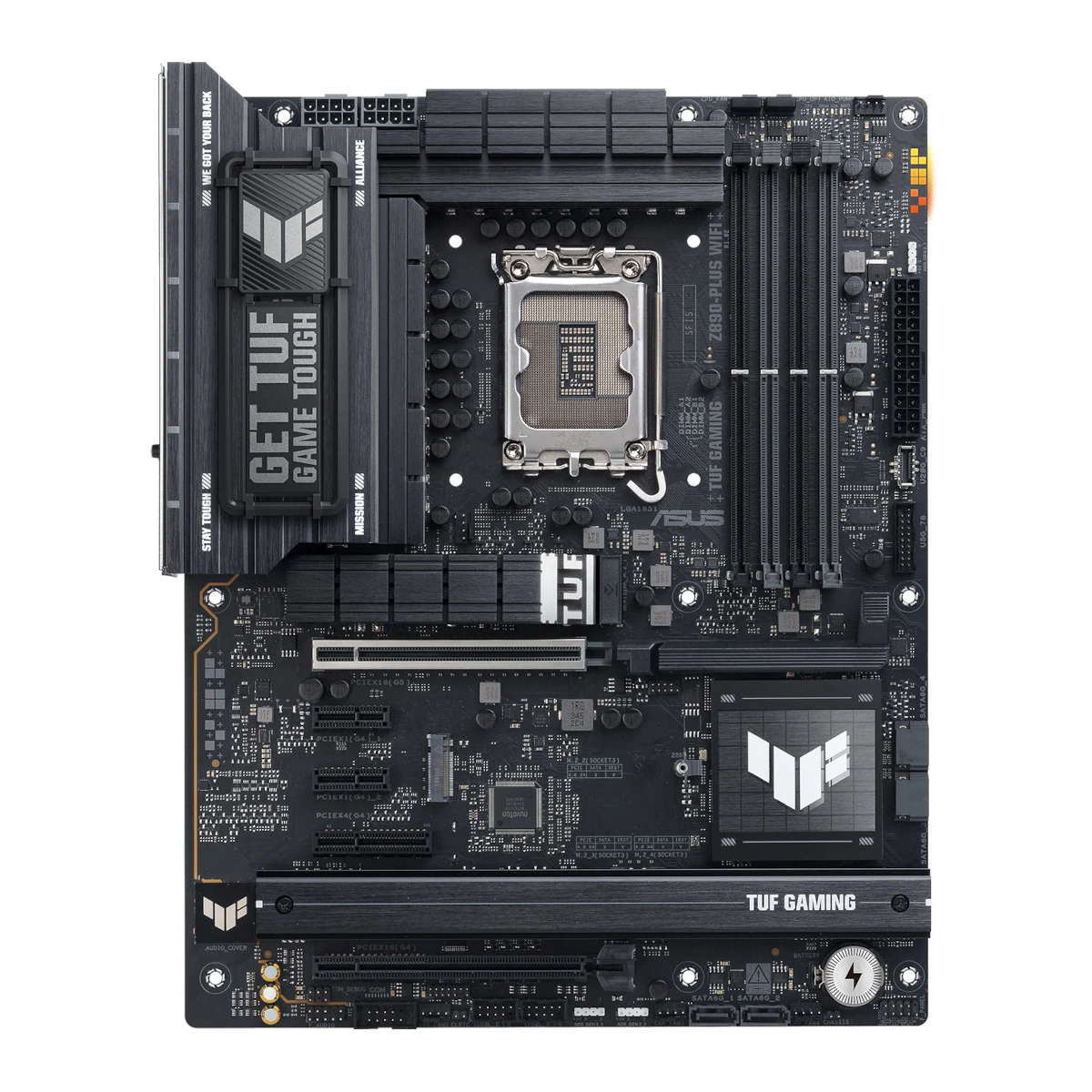
There are two TUF Gaming Z890 motherboards: Z890-Pro WiFi and Z890-Plus WiFi.
| Z890-Pro WiFi | Z890-Plus WiFi | |
|---|---|---|
| Form factor | ATX | ATX |
| VRM | 16+1+2+1, 80A | 16+1+2+1, 80A |
| RAM support | Slots: 4 Capacity: 192GB Speed: 9,066+MT/s | Slots: 4 Capacity: 192GB Speed: 9,066+MT/s |
| PCIe expansion | PCIe 5.0 x16 (x1) PCIe 4.0 x16 (x1) PCIe 4.0 x4 (x1) PCIe 4.0 x1 (x2) | PCIe 5.0 x16 (x1) PCIe 4.0 x16 (x1) PCIe 4.0 x4 (x1) PCIe 4.0 x1 (x2) |
| Storage | PCIe 5.0 x4 (x1) PCIe 4.0 x4 (x3) SATA 6Gbps (x4) | PCIe 5.0 x4 (x1) PCIe 4.0 x4 (x3) SATA 6Gbps (x4) |
| Networking | Intel 2.5Gbps (x1) Wi-Fi 7 (x1) | Intel 2.5Gbps (x1) Wi-Fi 7 (x1) |
| Audio | Realtek ALC 1220P | Realtek ALC 1220P |
| Rear USB | Thunderbolt 4 (x2) 10Gbps Type-A (x6) | Thunderbolt 4 (x1) 20Gbps Type-C (x1) 10Gbps Type-A (x3) 5Gbps Type-A (x3) |
| Front USB | 20Gbps Type-C (x1) 5Gbps Type-A (x2) 480Mbps Type-A (x4) | 20Gbps Type-C (x1) 5Gbps Type-A (x2) 480Mbps Type-A (x4) |
| Price | £378 | £370 |
Pro / Plus WiFi
There’s just £8 separating Z890-Pro WiFi and Z890-Plus WiFi. Their specifications are very similar, with the same 16+1+2+1 power phase design, PCIe expansion slots, and M.2 ports. Surprisingly, though, there are more differences between the two than their difference in price lets on.
The most obvious is the amount and speed of each motherboard’s USBs. Pro WiFi is the cheapest model in Asus’ lineup to offer two Thunderbolt 4 ports, with Plus WiFi boasting just one. The latter trims bandwidth back further with three 10Gbps Type-A headers in place of the six on the former, making up the difference with three 5Gbps Type-A connectors.
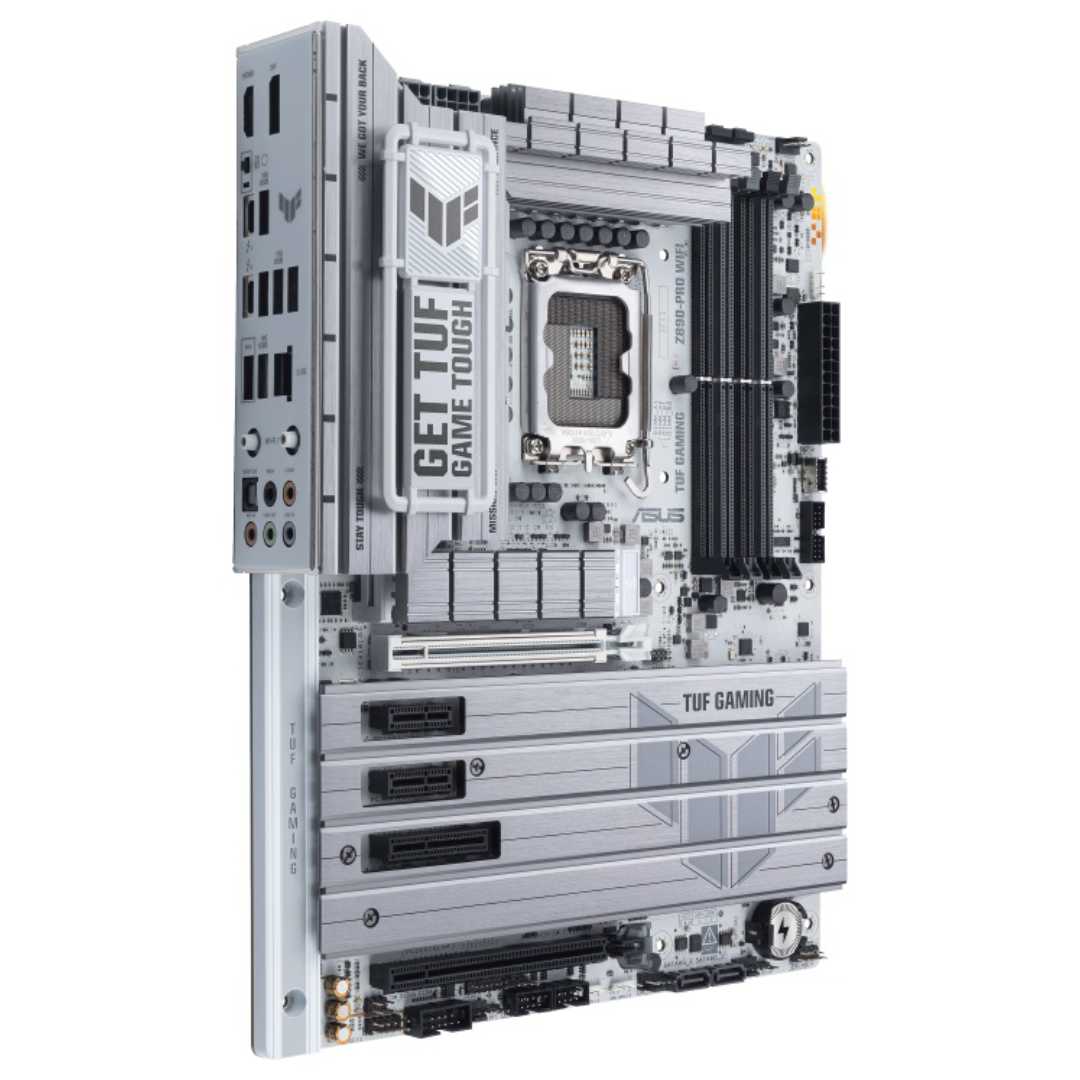
Asus TUF Gaming Z890
Built to last, the TUF line-up packs the same roster of features as its brethren but with a more militaristic aesthetic, creating a strong look and feel.
The slightly more expensive board also offers an additional heatsink cover for M.2 SSDs if you’re short of stock cooling for your drives. Additionally, Pro WiFi is also the cheapest motherboard to feature Asus’ PCIe Slot Q-Release Slim system. It’s a minor difference, as Plus WiFi boasts PCIe Slot Q-Release, but it’s another example of a more premium feature not making the cut.
With so little difference in cost between the two boards, Pro WiFi comes out head and shoulders above Plus. Sure, it’s more difficult to maintain a cohesive aesthetic with a white board, but all the aforementioned specification advantages vastly outweigh this drawback.
ProArt
Professionals deserve professional PCs, whether you’re an artist, editor, or need a reliable workstation for another digital profession. Asus’ ProArt motherboards tie into the company’s wider ecosystem, creating a cohesive workspace for creatives. They provide unique software features, boast high-end hardware, and aim to please with their more reserved, refined aesthetic.
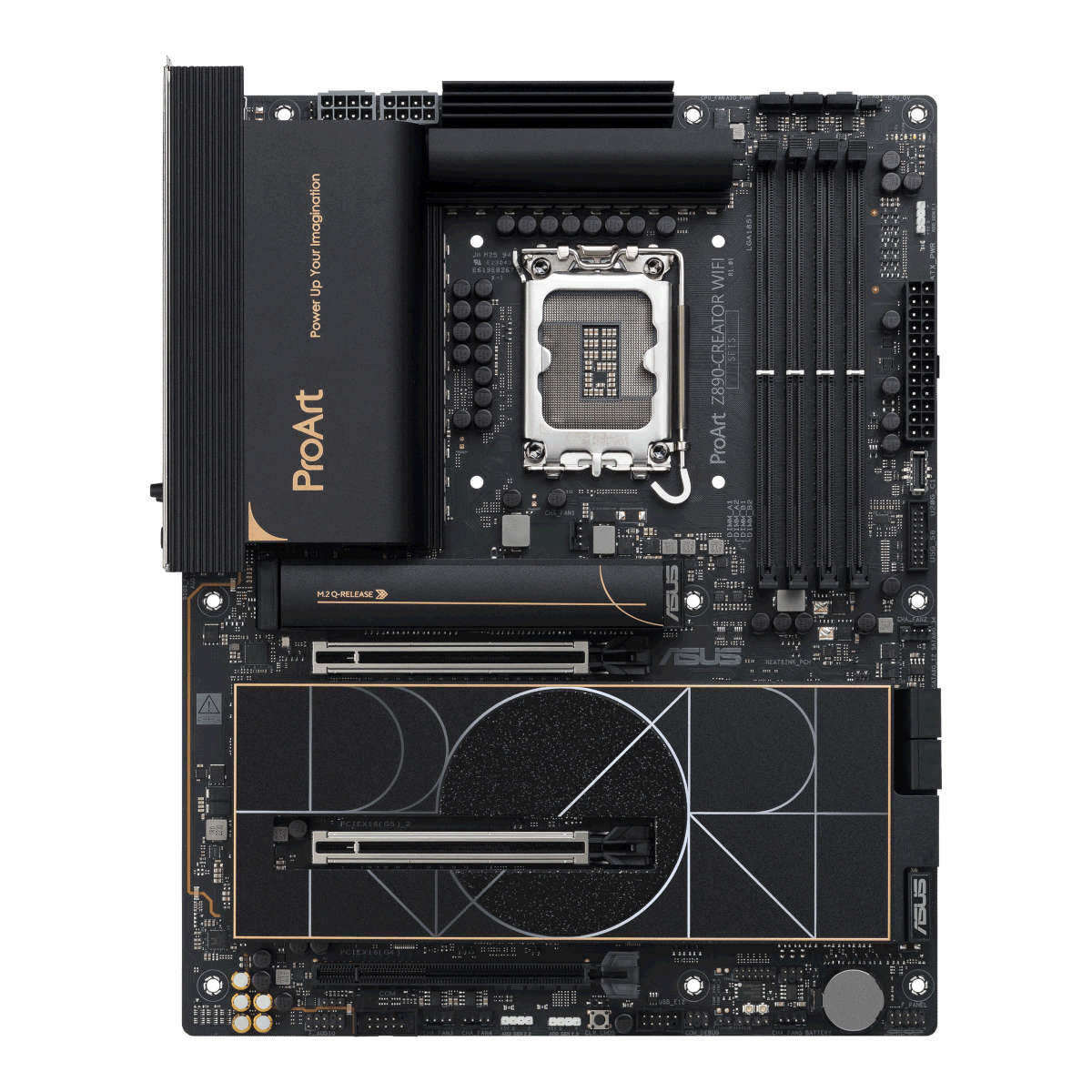
There is one ProArt Z890 motherboard: Z890-Creator WiFi.
| Z890-Creator WiFi | |
|---|---|
| Form factor | ATX |
| VRM | 16+1+2+2, 90A |
| RAM support | Slots: 4 Capacity: 192GB Speed: 9,066+MT/s |
| PCIe expansion | PCIe 5.0 x16 (x2) PCIe 4.0 x16 (x1) |
| Storage | PCIe 5.0 x4 (x1) PCIe 4.0 x4 (x4) |
| Networking | Marvell AQtion 10Gbps (x1) Intel 2.5Gbps (x1) Wi-Fi 7 |
| Audio | Realtek ALC1220P |
| Rear USB | Thunderbolt 5 (x2) Thunderbolt 4 (x1) 10Gbps Type-A (x6) 480Mbps Type-A (x1) |
| Front USB | 20Gbps Type-C (x1) 5Gbps Type-A (x2) 480Mbps Type-A (x2) |
| Price | TBC |
Creator WiFi
Right off the bat, Creator WiFi impresses with its internal and external connectivity. It’s the only other Asus motherboard to feature Thunderbolt 5 ports and 10Gbps networking outside of ROG Maximus Extreme. However, it actually one-ups the gaming board with an additional Thunderbolt 4 header and an extra sixth 10Gbps Type-A connector. While its overall USB count is fewer, all but the single 480Mbps port hit hard.
As a ProArt motherboard, Creator WiFi unlocks support features such as USB Port Management. This tool lets you toggle USB ports as well as set them to read-only mode to mitigate potential data leaks. Similarly, you’re also able to curate a software blacklist as well as disable the registry editor remotely for added security. Finally, WorkSmart allows you to create a bundle of applications to launch simultaneously, speeding up your workflow.
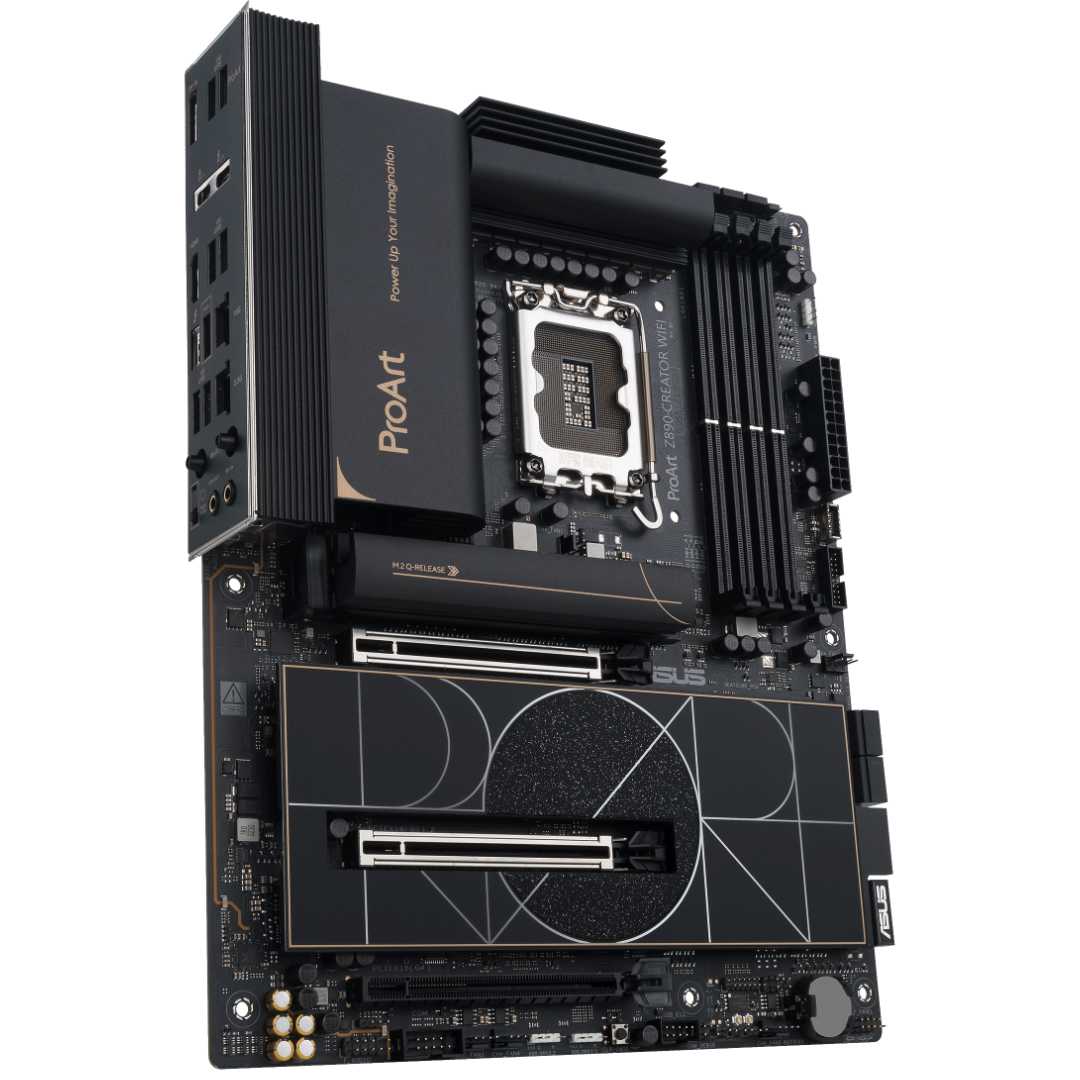
Asus ProArt Z890-Creator WiFi
With a spectacularly arty design, ProArt Z890-Creator focuses on memory, DIMM Fit, and AEMP III support so you can quickly access your assets and datasets without hesitation.
For added peace of mind, Asus rigorously tests the stability and reliability of each Creator WiFi motherboard. It can withstand ambient temperatures of up to 45°C and relative humidity of up to 80%. So, whatever the weather or environment, it shouldn’t let you down.
Finally, there’s no denying the beauty of this board. There’s nothing like an understated black-and-gold colour scheme to communicate luxury. The absence of screws across its M.2 slots further adds to its clean look, thanks to convenient features, including M.2 Q-Latch and M.2 Q-Release.
Prime
Finally, we have the Prime family. Built with budget builders in mind, these models are the most affordable of all Asus offerings. You won’t find RGB or toolless mechanisms here, as their sole purpose is to provide a solid foundation for Core Ultra 200S processors at minimal expense.
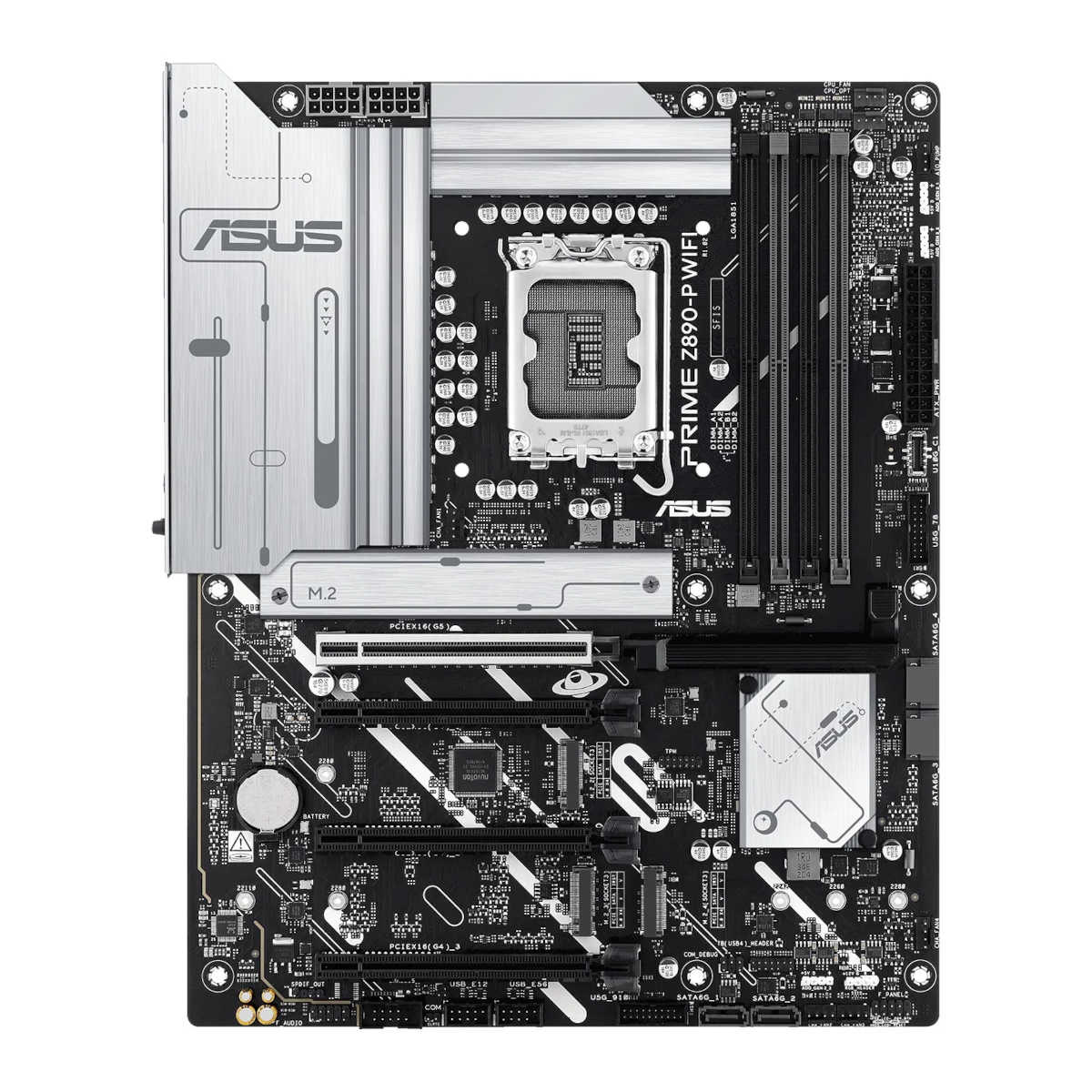
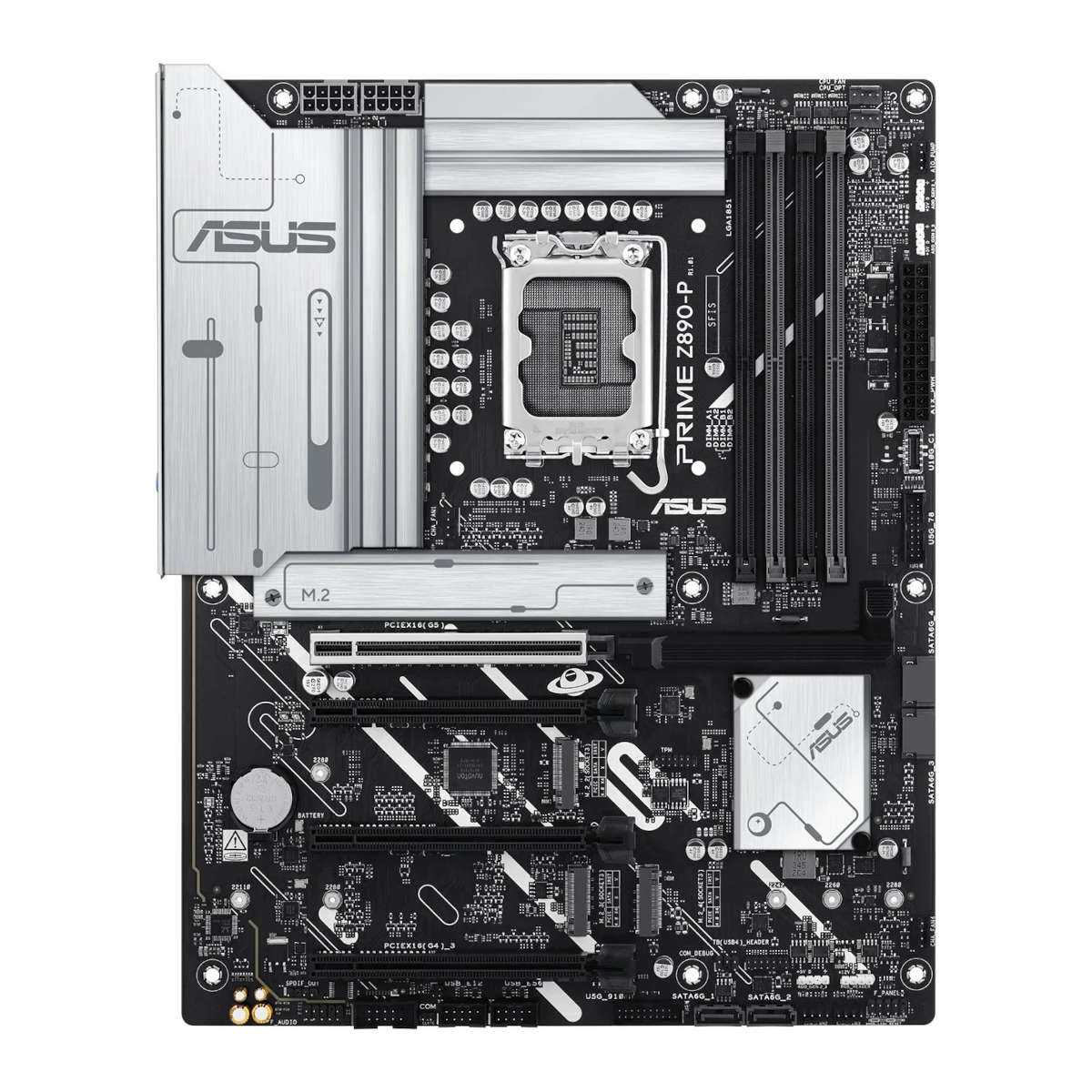
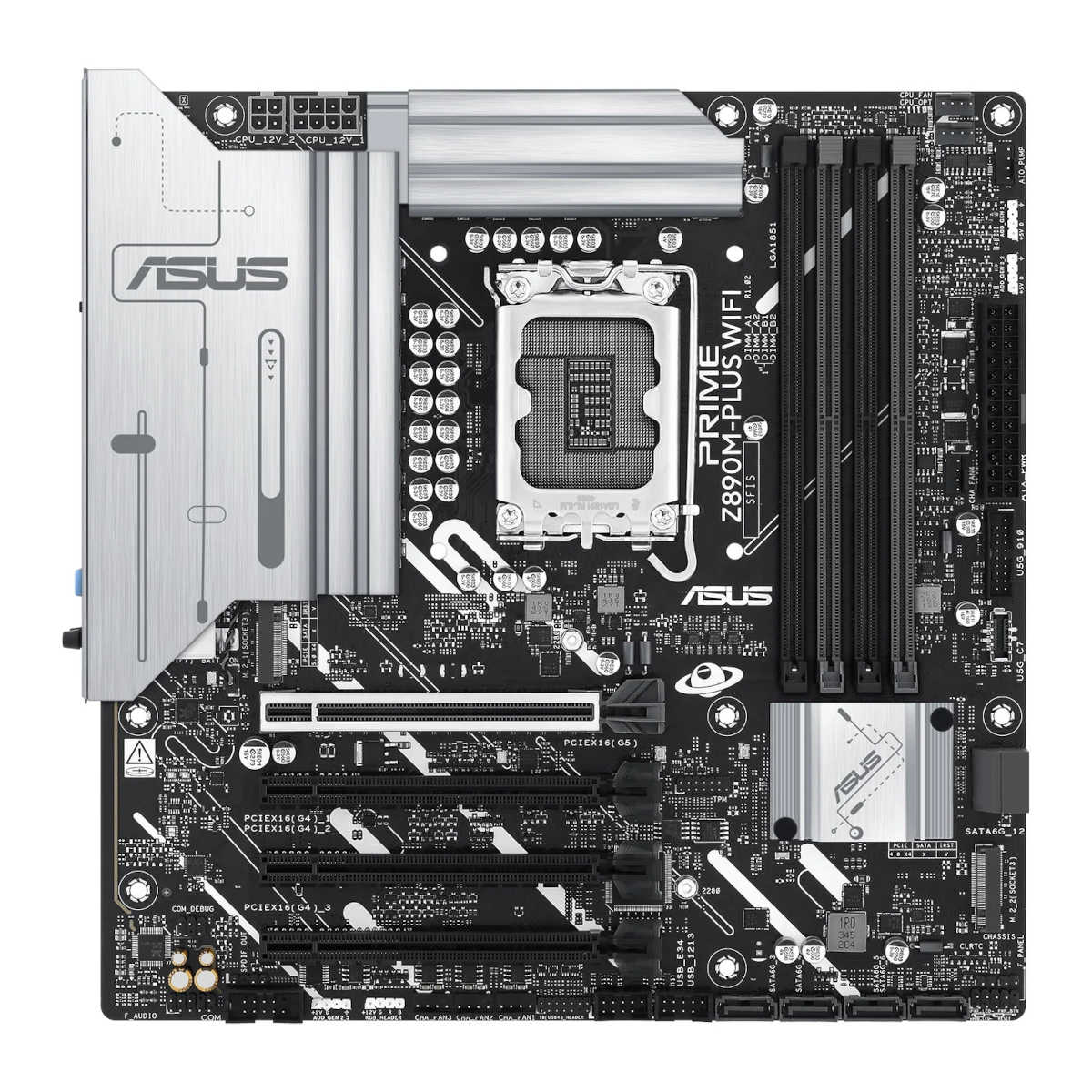
There are three Prime Z890 motherboards: Z890-P WiFi, Z890-P, and Z890M-Plus WiFi.
| Z890-P WiFi | Z890-P | Z890M-Plus WiFi | |
|---|---|---|---|
| Form factor | ATX | ATX | mATX |
| VRM | 14+1+2+1, 80A | 14+1+2+1, 80A | 10+1+2+1, 80A |
| RAM support | Slots: 4 Capacity: 192GB Speed: 8,400+MT/s | Slots: 4 Capacity: 192GB Speed: 8,400+MT/s | Slots: 4 Capacity: 192GB Speed: 8,400+MT/s |
| PCIe expansion | PCIe 5.0 x16 (x1) PCIe 4.0 x16 (x3) | PCIe 5.0 x16 (x1) PCIe 4.0 x16 (x3) | PCIe 5.0 x16 (x1) PCIe 4.0 x16 (x3) |
| Storage | PCIe 5.0 x4 (x1) PCIe 4.0 x4 (x3) SATA 6Gbps (x4) | PCIe 5.0 x4 (x1) PCIe 4.0 x4 (x3) SATA 6Gbps (x4) | PCIe 5.0 x4 (x1) PCIe 4.0 x4 (x2) SATA 6Gbps (x6) |
| Networking | Realtek 2.5Gbps (x1) Wi-Fi 7 | Realtek 2.5Gbps (x1) | Realtek 2.5Gbps (x1) Wi-Fi 7 |
| Audio | Realtek ALC897 | Realtek ALC897 | Realtek ALC897 |
| Rear USB | Thunderbolt 4 (x1) 10Gbps Type-A (x1) 5Gbps Type-A (x2) 480Mbps Type-A (x4) | 20Gbps Type-C (x1) 10Gbps Type-A (x1) 5Gbps Type-A (x2) 480Mbps Type-A (x4) | 20Gbps Type-C (x1) 10Gbps Type-A (x1) 5Gbps Type-A (x4) 480Mbps Type-A (x2) |
| Front USB | 10Gbps Type-C (x1) 5Gbps Type-A (x4) 480Mbps Type-A (x4) | 10Gbps Type-C (x1) 5Gbps Type-A (x4) 480Mbps Type-A (x4) | 10Gbps Type-C (x1) 5Gbps Type-A (x2) 480Mbps Type-A (x4) |
| Price | £285 | £235 | £259 |
P / P WiFi
As their names suggest, one of the core differences between Z890-P and Z890-P WiFi is support for wireless networking. Each sport 2.5Gbps Ethernet, making the trade-off easy to stomach if you’ve little use for Wi-Fi 7 and Bluetooth 5.4.
That said, there is another important difference between the two motherboards: support for Thunderbolt 4. Z890-P WiFi is the cheapest model to support the standard in Asus’ lineup, with Z890-P opting for a 20Gbps Type-C port instead.
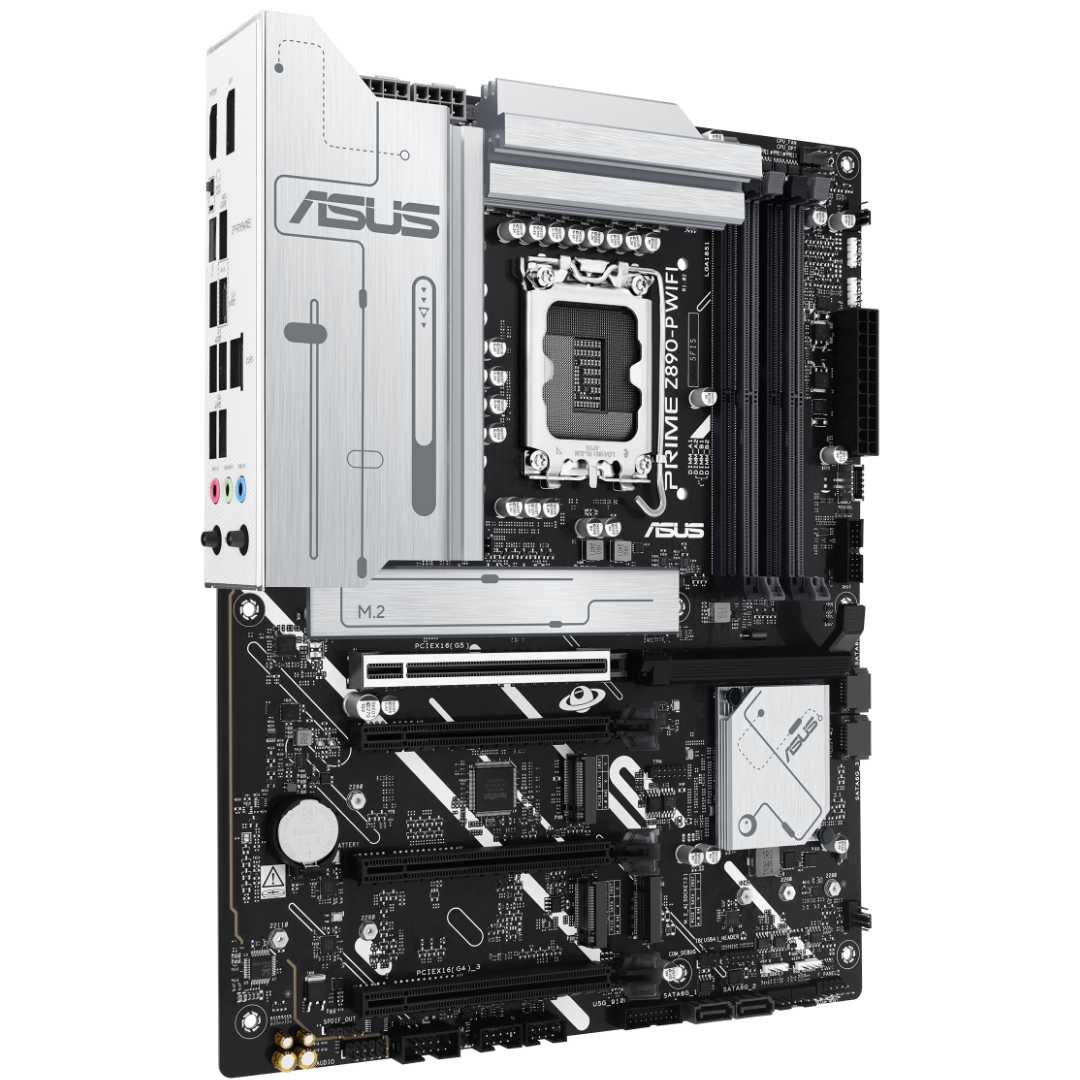
Prime Z890-P WiFi
Whether you want blazing-fast wireless and wired connectivity or something slightly cheaper that still meets the bar, Prime Z890-P has something for you.
These two separations in specifications are what constitute the £50 price gap between Z890-P and Z890-P WiFi. Either has the qualities to create a budget bedrock for a Z890 system, offering at least one PCIe 5.0 expansion and M.2 slot per the chipset’s specifications. However, Asus sweetens the deal with a welcome addition of PCIe 4.0 slots.
M-Plus WiFi
Asus rounds off its Prime family with an mATX model: M-Plus WiFi. This stout little board sits between its siblings in terms of price, at £259. Despite its smaller stature, Asus manages to retain much of the same functionality you’ll find on either ATX alternative.
The smaller PCB understandably leaves less room for power stages, reduced to 10+1+2+1 down from 14+1+2+1. However, this count mirrors the more expensive ROG Strix Z890-I Gaming WiFi (albeit with 80A SPS rather than 110A).
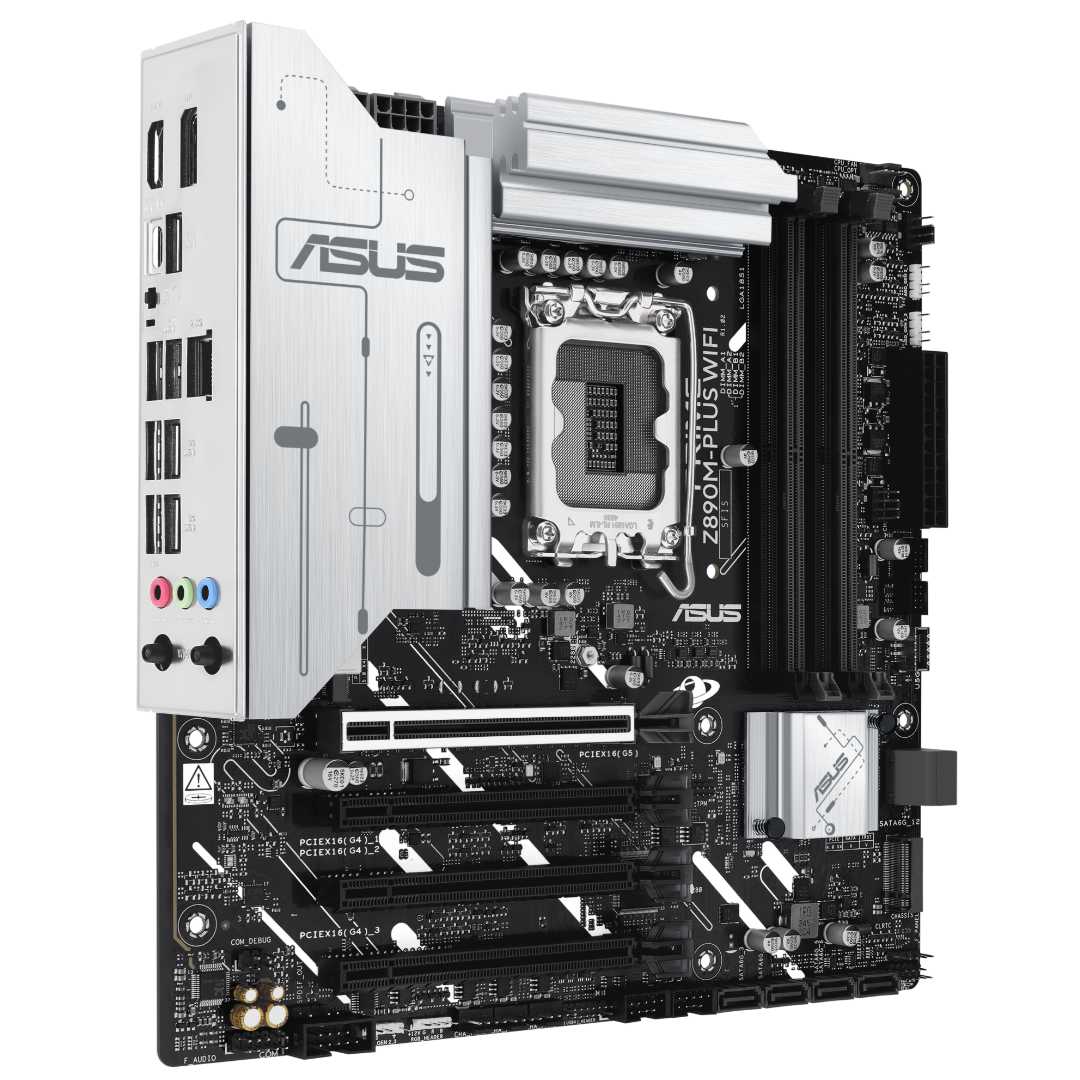
Asus Prime Z890M-Plus WiFi
Asus manages to keep everything that makes its full-sized Prime series special and crams it into a small form factor mATX alternative.
Aside from this change, though, the only major difference between it and other Prime Z890 motherboards is its number of PCIe 4.0 x4 slots, which fall from three to two. Its rear I/O actually has more bandwidth than Z890-P, with a greater number of 5Gbps Type-A ports.
AIO coolers
Finally, I’d like to highlight Asus’ series of AIO water coolers, each of which features a model designed to specifically complement the aesthetics of each motherboard family.
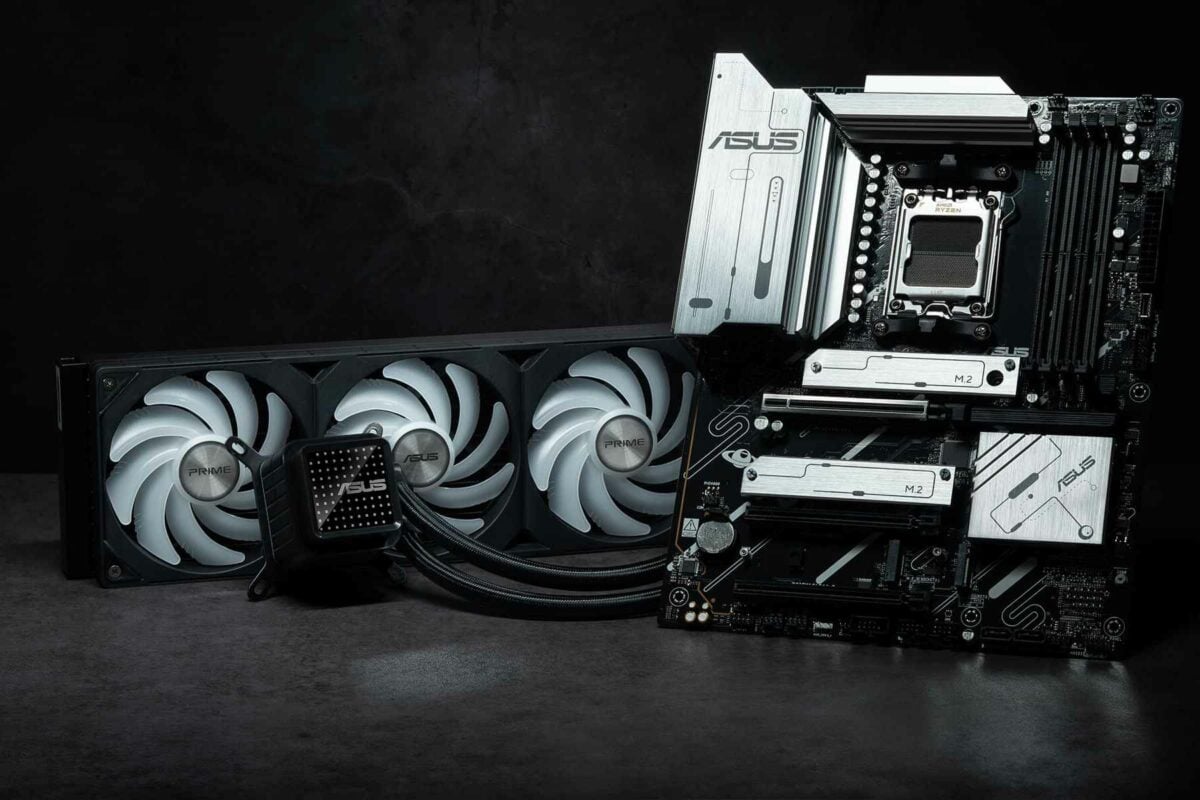
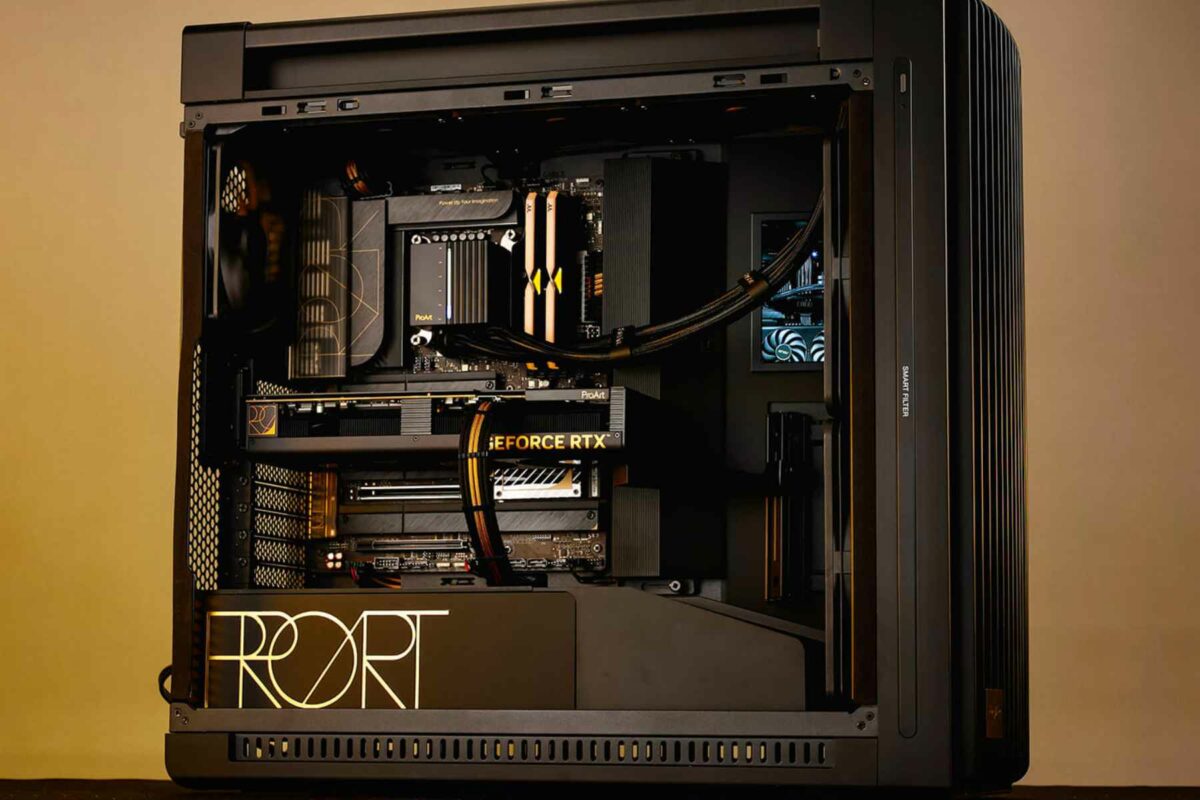
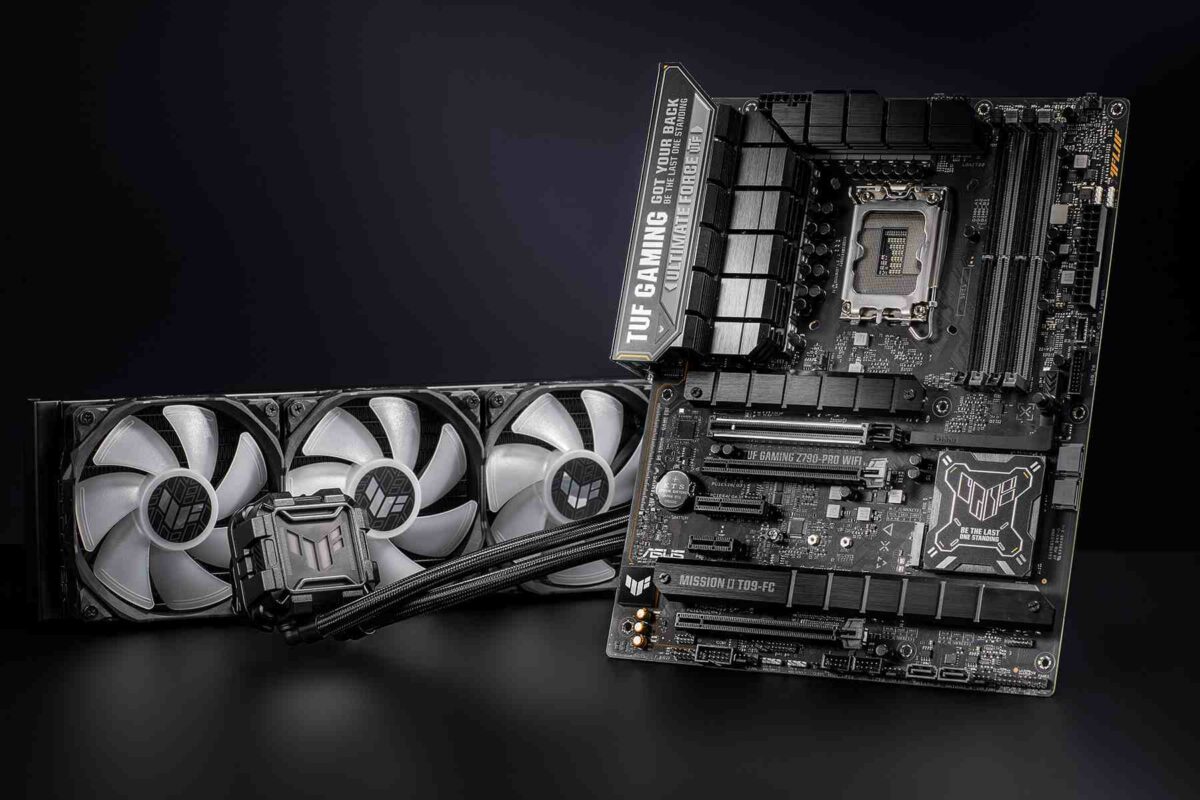
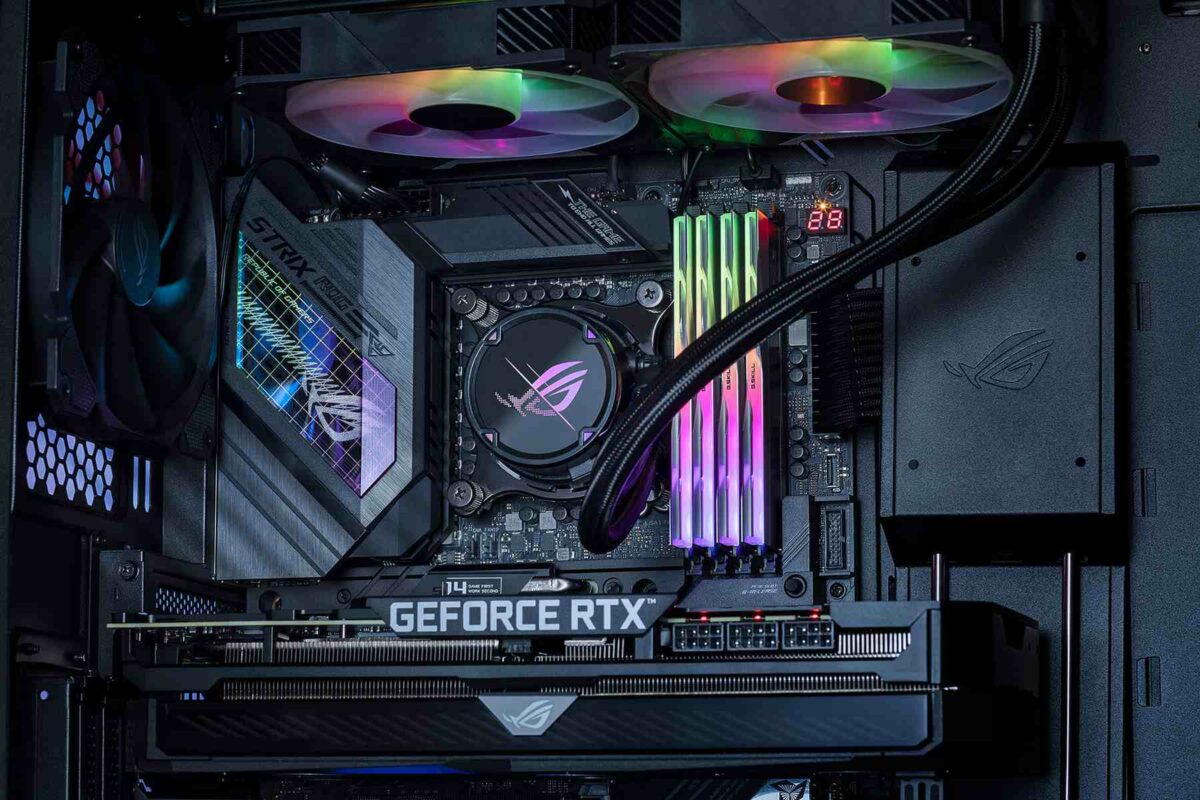
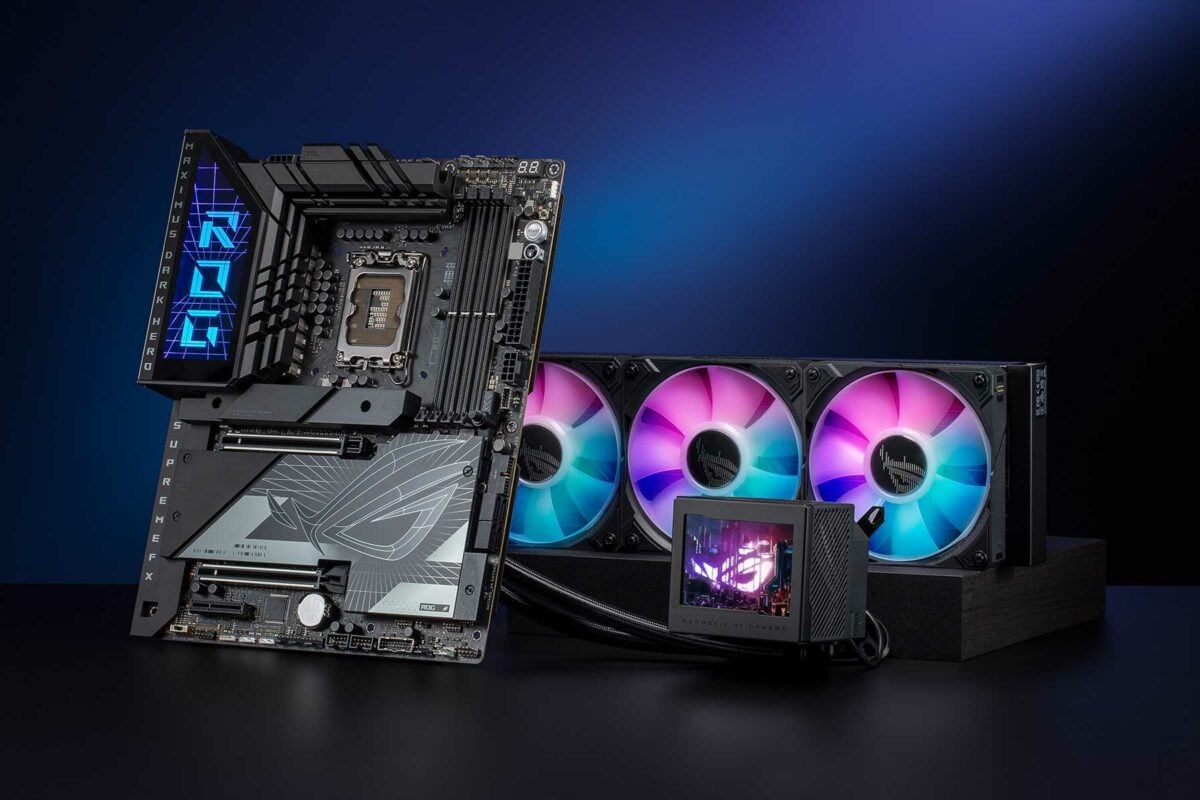
ProArt takes the tastefully stealthy approach with its all-black finish, while Prime, TUF Gaming, and Strix Series glow with ARGB to match their corresponding motherboard. You can opt for a 2.1in circular LCD screen on the Strix models, which acts as a slightly cheaper alternative to the 3.5in 16:9 panels on top of ROG Ryujin. I’ve had plenty of fun putting Nyan Cat on my CPU screen, but you could do something far more useful, like display system temps.
All models are available in either 240mm or 360mm models, with the exception of ProArt, which comes in 360mm or 420mm flavours. It’s refreshing to see some love for 140mm fans but note that Asus ships with Noctua NF-A14 rather than its own in-house solution.
ProArt LC 420 could very well be the go-to for cooling enthusiasts, but ROG Ryujin III 360 Extreme makes a fantastic case for itself at the top of the stack. Not only is it the only one to feature a full-colour IPS LCD, but it also packs an embedded VRM fan, Asetek’s Emma Gen8 V2 pump, and fans that offset by +/- 10% to combat harmonic resonance.
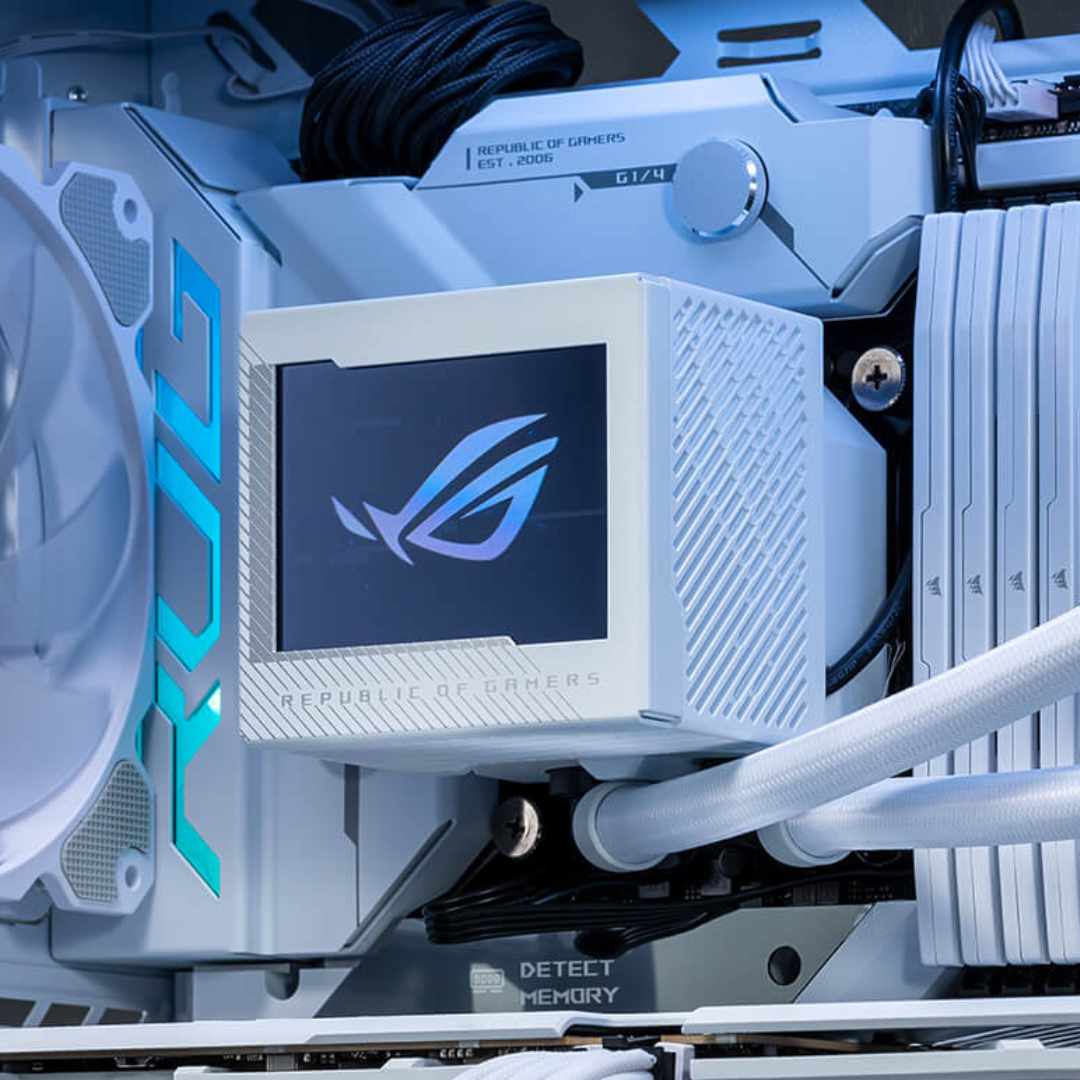
Asus ROG Ryujin III 360
Fuse style and performance with ASUS AIO coolers, now designed with X870E/X870 series motherboards and Intel’s latest LGA1851 socket in mind.
Backwards compatibility will vary depending on the model you choose, but all are designed with LGA1851 in mind. Most support LGA 1700, 1200, and 115x, too, but you should check before purchasing. Each is backed by a six-year warranty, keeping you in the game for as long as possible.
With all the information and specs sheets above, finding the right Asus Z890 motherboard for your system should prove much easier. If you’re hungry for more Core Ultra 200S coverage, be sure to check out our Intel Core Ultra 9 285K review.

